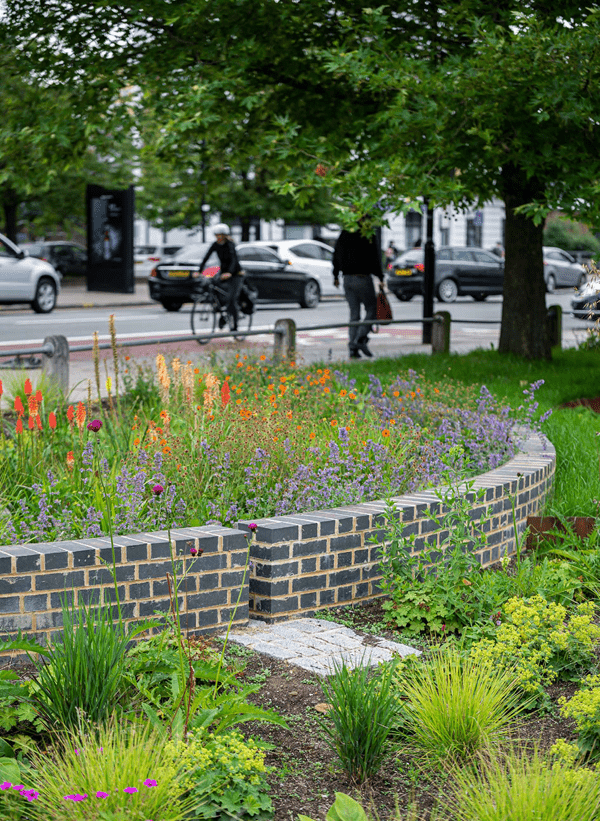Published: May 2023
Preface
Why this supplementary planning guidance (SPG) is needed
Our understanding of the negative impacts of conventional drainage on the environment are now well understood.
Pipe drainage collects and conveys water away from where it rains, as quickly as possible, contributing to increased risk of flooding, likelihood of contaminated water and the loss of our relationship with water and the benefits it can bring to people and wildlife.
Sustainable Drainage Systems, or SuDS, are ways of managing rainfall that mimic the drainage processes found in nature and addresses the issues with conventional drainage.
The reasons for a new approach to managing rainfall are clear. It is therefore important that everyone involved in delivering SuDS is familiar with both the ideas behind the approach and the way they should be implemented through the new Belfast Local Development Plan.
Who this SPG is intended for
The use of SuDS in new developments is promoted as the preferred approach under the subject policy ‘Planning and Flood Risk’ contained within the Strategic Planning Policy Statement for Northern Ireland (SPPS).
The Local Development Plan for Belfast contains policy specifically relating to the promotion of SuDS.
This SPG will be used by BCC planning department in assessing planning applications. Developers and their consultants should use this SPG as guidance on how BCC expect SuDS to be integrated into all development, including permitted development works.
What the SPG provides
This SPG promotes the idea of integrating SuDS into the fabric of development using the available landscape spaces as well as the construction profile of buildings. This approach provides more interesting surroundings, cost benefits, and simplified future maintenance.
It is intended that this guide will facilitate consultation, in order to achieve the best possible SuDS designs.
Copyright © 2023 Robert Bray Associates and McCloy Consulting
Unless otherwise stated, the copyright and any other rights in all material on this webpage (relating to the Belfast City Council Sustainable Drainage Systems (SuDS) SPG) are owned by Robert Bray Associates Limited and McCloy Consulting Limited. These works are protected by copyright laws and treaties around the world. All such rights are reserved. You are permitted to print and download extracts from this webpage only on the following basis:
- use of documents and related graphics on this site are for personal use only;
- any copies of these pages saved to disk or to any other storage medium may only be used for subsequent viewing purposes or to print extracts for personal use;
- no graphics or text on this webpage are to be modified in any way;
- no part of this webpage may be reproduced or stored in any other website or included in any public or private electronic retrieval system or service without our prior written permission;
- you must not use any part of the materials on this webpage (relating to the Belfast City Council Sustainable Drainage Systems (SuDS) SPG) for commercial purposes without obtaining a licence to do so from Robert Bray Associates Limited and McCloy Consulting Limited to so.
Contents
- Introduction
- Policy context
- Understanding Rainfall
- 4The Impact of Development
- The Role of SuDS
- SuDS in the Belfast Context
- Some misunderstandings about SuDS
- Designing SuDS
- SuDS - A range of features
- SuDS for every location
- Managing SuDS now and in the future
- Glossary and list of acronyms
1.0 Introduction
‘Sustainable Drainage or SuDS is a way of managing rainfall that minimises the negative impacts on the quantity and quality of runoff whilst maximising the benefits of amenity and biodiversity for people and the environment’.
The SuDS Manual, published by CIRIA 2015
1.1 Introduction
1.1.1 Belfast is a growing city. Increasing population and urbanisation are adding further pressure to a drainage system which is already under stress. Belfast City Council wants new development to incorporate drainage systems that reflects the type of city we want to have; that manages flood risk, deals with pollution, provides habitat for biodiversity and pleasurable surroundings in which to live and work. In short, the Local Development Plan advocates that Sustainable drainage should be incorporated into all new development which is outlined in detail in Policy ENV5.
‘All built development should include, where appropriate, SuDS measures to manage surface water effectively on site, to reduce surface water runoff and to ensure flooding is not increased elsewhere. A two stage SuDS treatment should be used, where possible, in order to improve water quality. An appropriate maintenance and management plan for all SuDS will require to be agreed with the council and a s76 planning agreement may also be sought’.
ENV5 – Sustainable drainage systems (SuDS)
1.1.2 This SPG provides guidance on how Policy ENV5 will be applied in assessing planning applications. The main objectives of this Supplementary Planning Guidance are:
- To create a shared vision around SuDS for all involved in design and planning system.
- To enable SuDS design to meet the requirements of Belfast City Council Local Development Plan (LDP)
- To ensure SuDS are well designed, meet the needs of the community and can be easily maintained in the future.
1.2 Other relevant documents
1.2.1 This SuDS SPG is part of a suite of SPGs across a range of topics, including flood risk and design. All relevant SPGs should also be taken into account in considering new development proposals.
1.2.2 Signposts are provided within the SPG for further guidance where appropriate. This SPG is also complementary to the following documents.
Strategies
- Belfast Green and Blue Infrastructure Plan
- Belfast Agenda
- BCC ‘s Belfast Open Spaces Strategy (BOSS)
- Living With Water Programme
Industry Guidance
- The SuDS Manual (CIRIA 2015)
- SuDS Design and Evaluation Guide (McCloy Consulting and Robert Bray Associates 2018)
2.0 Policy context
2.1 Regional Planning policy and guidance
Regional Development Strategy (RDS) 2035
2.1.1 The RDS provides a series of Regional Guidance (RG) and Spatial Framework Guidance (SFG), a number of which relate to the Belfast Metropolitan Urban Area (BMUA). Policy RG9 and RG12 specifically mention SuDS and the requirement for all development, including those located outside flood risk areas, to include SuDS.
2.1.2 The other RG which is strongly linked with SuDS is RG11, which encourages green and blue infrastructure within urban areas and requires the protection of existing ecological networks. SuDS will also contribute to SFG5 (Protect and enhance the quality of the setting of the BMUA and its environmental assets) with the opportunity for the improvement in storm water runoff quality discharging to the Lagan and Belfast Lough.
Strategic Planning Policy Statement (SPPS) for Northern Ireland (2015)
2.1.3 The SPPS notes that the planning system should help to mitigate and adapt to climate change by working with natural environmental processes, for example through promoting the development of green infrastructure and also the use of sustainable drainage systems (SuDS) to reduce flood risk and improve water quality.
2.1.4 The SPPS recognises that in managing development, particularly in areas susceptible to surface water flooding, planning authorities should encourage developers to use sustainable drainage systems (SuDS) as the preferred drainage solution.
2.1.5 The SPPS notes that such systems are widely used in other UK jurisdictions and have been shown to be more effective than traditional piped drainage in reducing surface water flooding as well as providing other environmental, economic and social benefits. Furthermore, using permeable materials for hard landscaped surfaces in new developments can reduce soil sealing.

2.2 Local Policy
Plan Strategy
2.2.1 The Plan Strategy provides the strategic policy framework for the plan area as a whole across a range of thematic areas. It sets out the vision for Belfast as well as the objectives and strategic policies required to deliver that vision. The preference for the inclusion of SuDS are referenced on a number of occasions as within the LDP including the following policies:
- Sustainable Drainage Systems (ENV5).
- Environmental Quality (ENV1) which specifically mentions green roofs.
- Adapting to environmental change (ENV3).
- Flood Risk (ENV4).
- Water and sewerage infrastructure (ITU2) which highlights the need to integrate water and land use planning and encourages greater use of SuDS.
- Master planning approach for major development (DES2) which recognises that SuDS should be designed as an integral part of the landscape design and open space provision.
- Green and blue infrastructure network (GB1) identifies that new development should incorporate green infrastructure features as part of the design, including green roofs and walls, SuDS, tree and hedgerow planting, and creating safe accessible links with neighbouring open space, in addition to providing open space on site, where appropriate.
2.2.2 The SuDS policy (ENV5) is aligned with the measures that also form part of the city’s green and blue infrastructure which are supported by the council’s Green and Blue Infrastructure Plan.
2.2.3 ENV 5 states that developers should consider the following SuDS measures to assist in minimising flood risk:
- Green roofs (intensive and/or extensive systems);
- Swales;
- Filter strips and filter drains;
- Permeable or porous paving;
- Detention basins;
- Open areas, ponds and wetlands; and
- Trees and landscaping.
Local Policies Plan
2.2.4 Once adopted, the Local Policies Plan (LPP) will set out site-specific proposals in relation to the development and use of land in Belfast. It will contain local policies, including site-specific proposals, designations and land use zonings required to deliver the Council’s vision, objectives and strategic policies, as set out in the Plan Strategy.
3.0 Understanding Rainfall
It is important that everyone involved in the design and review of SuDS has an understanding of the natural processes that occur in response to rain, so that proposed schemes can mimic these.
3.1 It begins to rain
3.1.1 In forests, glades, and wetlands, when it rains, water can be lost in a number of ways. The rain is held on the foliage of trees and plants and evaporates into the air, falls to the ground to be absorbed by leaf litter and surface soil layers, or is ‘breathed’ back into the air by plants as transpiration. These losses are called interception losses and are the first part of the natural losses that occur during rainfall.

3.2 The ground becomes saturated
3.2.1 After a while the surface of the landscape can absorb no more water.
3.2.2 Where the ground is permeable, water begins to soak into lower soil profiles and then the underlying geology. This is called infiltration and is common on sandy, gravelly and limestone soils.
3.2.3 Where the ground is impermeable, water begins to trickle and flow across the surface, collects in natural depressions, and is stored in wetlands. These natural features attenuate the rate and volume of flow of rainwater running off the landscape. These flows are called natural or greenfield runoff.
2. Surface flow rates are small at first, but increase with higher intensity rainfall events. The volume of runoff will be greater with increased rainfall intensity and duration.
3.3 Natural losses continue during heavy rain
3.3.1 In many soils, both a degree of infiltration and surface runoff can occur simultaneously.
3.3.2 Once the ground is saturated there are ongoing natural losses that occur during rainfall, particularly where the ground has some permeability.
3.3.3 During warmer weather when the ground is relatively dry, interception and ongoing natural losses will occur during most rainfall events.
Interception and ongoing losses are the two elements of total natural losses.
4.0 The Impact of Development
For millennia, people have been making changes to our landscapes which affect the fate of the rain that falls on the land. In recent history, the scale of urbanisation and our attitudes toward rainwater have caused serious problems both for ourselves and for the natural environment.
4.1 A rural landscape becomes urban
4.1.1 Before the universal use of piped drainage it was common to collect and convey runoff across the land surface directly into ditches, streams and local rivers.
4.1.2 With the growth of Belfast and the development of piped drainage, human and industrial waste, together with rainwater runoff from buildings and streets, was directed into a single underground pipe called the combined sewer. Most of Belfast is served by a combined sewer system. Rainwater entering the combined sewer increases the frequency of raw sewage overflows into watercourses or worse when the sewer is overloaded excess flows come onto the street.
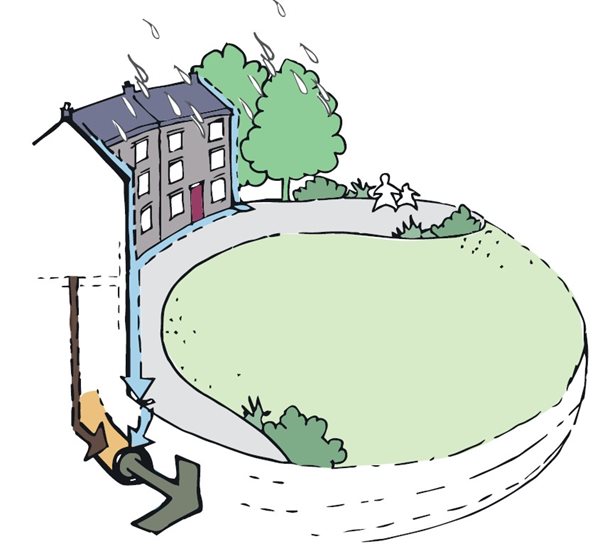
4.2 Separating rainwater from foul sewage
4.2.1 In the mid-twentieth century it was realised that foul sewage and storm water should be separated. A separate sewer arrangement was introduced with the foul sewer for human waste and the surface water sewer for rainfall. The Belfast drainage system includes many pockets of more recent development which are served by separate drainage systems, where storm water is kept separate and usually discharged to a nearby watercourse.
4.2.2 Unfortunately, even in new development, rainwater still gets into the foul sewer through misconnections. Using SuDS to manage rainfall can minimise these misconnections by keeping rainfall runoff at or near the surface.
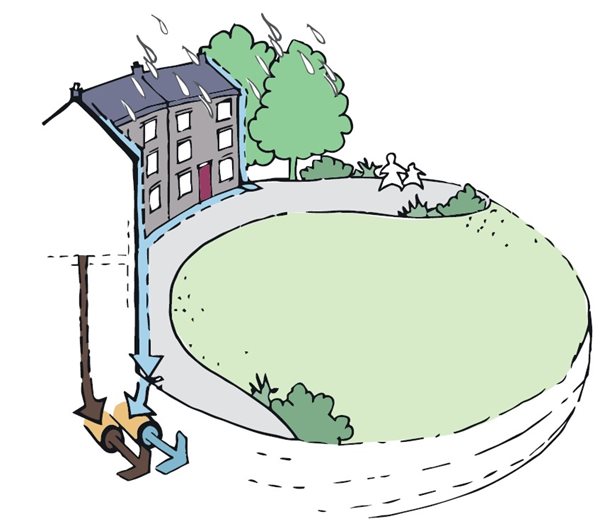
4.3 Consequences of piped drainage
4.3.1 Piped drainage is designed to convey water away from developments as quickly as possible, and has become the default way to manage rainfall across the developed world. However, this is at a cost to the environment and developments themselves.
4.3.2 The disadvantages of traditional piped drainage are now becoming clear:
- Quickly carrying rainwater away from where it falls can increase the risk of flooding elsewhere.
- More rainfall entering into a combined sewer system increases the frequency of times that dilute sewage is discharged into a watercourse whenever there is insufficient capacity in the sewer.
- Limited pipe and network capacity, as well as blockage, can cause local flooding as water cannot get into the piped drainage system.
- Pollution from roofs, roads and car parks is washed into the sewer when it rains, contaminating streams, rivers and Belfast Lough and killing wildlife.
- Recharge of groundwater and aquifers is prevented, and the natural ‘baseflow’ of water through the ground to watercourses is lost.
- ‘Flashy’ flows from urban areas can cause erosion of watercourses.
- Trees and plants in urban areas are at greater risk from drought stress, due to lack of access to rainwater.
- Wildlife is often trapped and killed by conventional drainage structures.
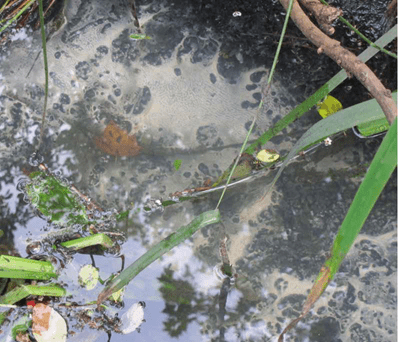
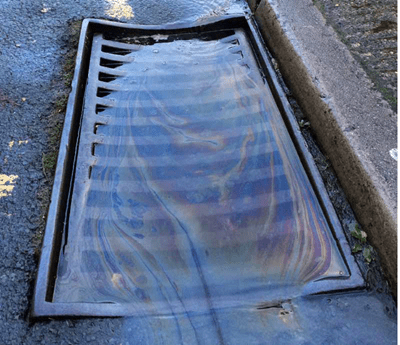
5.0 The Role of SuDS
Sustainable Drainage Systems manage rainfall in ways that mimic natural drainage processes and reduce the impact of development on communities and the environment.
5.1 SuDS addresses community and environmental problems
5.1.1 Conventional drainage seeks to remove runoff from development as quickly as possible. In contrast, SuDS slow the flow and store water in both hard and soft landscape areas, thereby reducing the impact of large volumes of polluted water flowing from development.
5.1.2 SuDS uses features linked in series to trap silt and heavy pollution ‘at source’. Contaminants are broken down naturally as runoff passes from one SuDS feature to the next.
5.1.3 Multi-functional SuDS features that manage water at or near the surface, can bring significant community benefits, adapting their function to the weather.
5.1.4 The loss of aquatic habitat is reversed when using the SuDS approach. These features allow fauna and flora to flourish, and to connect with existing habitats.
5.1.5 As the number of SuDS increase in the City it will be like a series of ‘sponges’ soaking up the rain and releasing it slowly for the benefit of us all. Although it will take time, the positive effects of SuDS will grow as more and more developments include features that collect, clean and store water where it falls as rain.
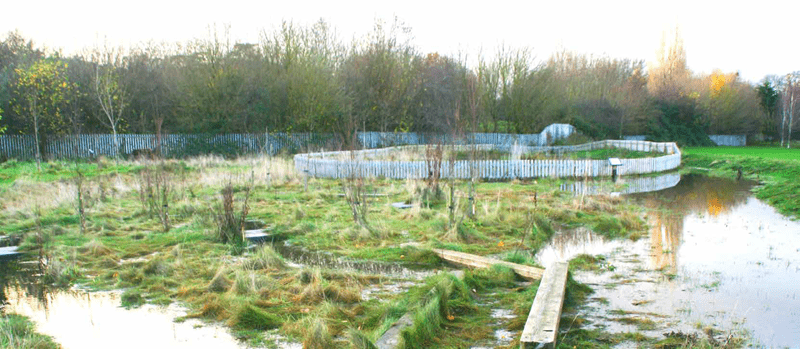
5.2 SuDS objectives
5.2.1 Where SuDS are designed as an integral part of the urban fabric they help mitigate the risk of flooding and the impact that development has on the natural landscape. They are also able to rehabilitate the hydrology of the urban environment through sustainable re-development and SuDS retrofit.
5.2.2 There are four critical objectives that SuDS seek to meet:
- Quantity: managing flows and volumes to match the rainfall runoff characteristics before development, in order to prevent flooding from outside the development, within the site and downstream of the development.
- Amenity: enhancing people’s quality of life through an integrated design that provides useful and attractive multi-functional spaces.
- Quality: preventing and treating pollution to ensure that clean water is available as soon as possible to provide amenity and biodiversity benefits within the development, as well as protecting watercourses, groundwater and the sea.
- Biodiversity: maximising the potential for wildlife through design and management of SuDS.
6.0 SuDS in the Belfast Context
6.1 Why are SuDS required in Belfast?
6.1.1 Climate change is a global phenomenon that largely impacts urban life. Rising global temperatures causes sea levels to rise, increases the number of extreme weather events such as significant storms, flooding and prolonged droughts. These changing weather patterns have costly impacts on cities’ basic services, infrastructure, housing, livelihoods and health. Belfast as a coastal city located in the Lagan Valley estuary at the base of the Belfast Hills to its west and Castlereagh Hills to its east means that it is highly vulnerable to these changes.
6.1.2 Our drainage systems have been subject to increasing pressure over recent years both through climate change and additional development. We have observed extreme rainfall with much greater regularity than previously witnessed. On a number of occasions this has resulted in widespread flooding of various parts of Belfast.
6.1.3 The future growth projections for Belfast with 60,000 additional population planned to be living in the city by 2035. There is a requirement for the development of the city to consider how people will live and work and ensure as far as possible that there is no increased pressure on our drainage networks.
6.1.4 BCC has identified SuDS (Policy ENV5) as the preferred way of managing rainfall from all future development. SuDS if well designed, will make a valuable contribution to Belfast, making it a more pleasant and healthy environment in which to live, work and play.
6.2 Flood risk
6.2.1 Belfast has a history of flooding mainly from its rivers when too much rainfall enters the river too quickly. This risk becomes more pronounced when high river flows coincide with high tidal levels in Belfast Lough. With more intense rainfall happening more frequently surface water flooding occurs when pipe inlets are full and runoff overflows locally across the city.

6.3 Geology
6.3.1 SuDS can be used on all types of geology, but equally the type of geology can influence SuDS design.
6.3.2 The area of Belfast City Centre and the Harbour lands is underlain by reclaimed land known locally as ‘Belfast Sleech’. The majority of west Belfast is underlain by Boulder Clay. The presence of clay and sleech with low permeability will limit potential for infiltration, with runoff required to be stored and slowly released to a watercourse or sewer.
6.3.3 To the south and east Belfast, Sand, Gravel and Alluvium deposits are present. These deposits may have the potential for infiltration where runoff can be released into the ground.
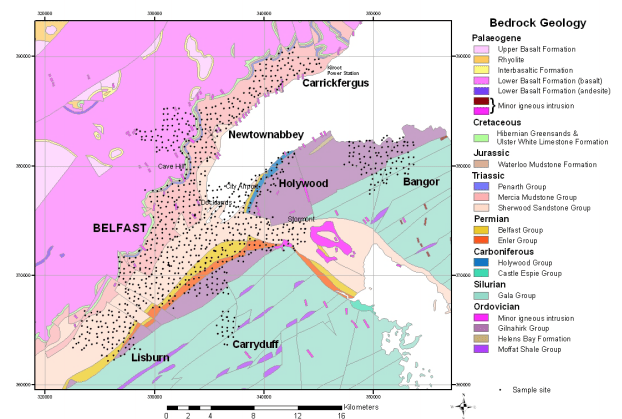
6.4 Drainage systems
6.4.1 Belfast’s network of combined sewers is reaching capacity, meaning that in heavy rainfall events there is a risk that surface water cannot enter the sewer, the sewers overflow and foul water is released into the rivers. When parts of the city are redeveloped and SuDS are incorporated, rainfall can be held and released slowly using SuDS. This will help reduce the rate at which water flows into the sewer network, freeing up space in the sewer and reducing the amount of water that needs to be treated in the waste water treatment plant. This additional space in the sewer can potentially be used to support the development of new homes.
6.5 Contaminated Land
6.5.1 Belfast is a city with a rich industrial past dating back to the industrial revolution. This has resulted in heavy engineering and manufacturing industries dominating the local economy both historically, and in recent times.
6.5.2 Much of the city centre and surrounding developed area may be considered brownfield land and new development sites may have, or be adjacent to, potentially contaminative former land uses.
6.5.3 The contamination status of each site will vary significantly and may require site-specific assessments to determine the extent of any contamination present and may also require implementation of site-specific remediation measures to protect human health. SuDS which are located close to surface can provide a simple, cost effective and beneficial solution to rainfall management on these sites, when compared with conventional drainage equivalent, due to reduced requirements for large or deep excavation. However, it will be important to ensure that any proposed SuDS are compatible with any required remediation measures.
Former industrial site, central Belfast.

6.6 The role of planning in SuDS
6.6.1 BCC considers that SuDS are appropriate and reasonably practicable in the majority of developments. Proposals for SuDS and how they integrate with the development can be discussed as part of the Pre-application discussion (PAD) meeting. A short checklist of the sort of information that can be gathered in preparation for the PAD meeting is contained in Appendix B.
6.6.2 BCC planners may wish to consult with statutory and non-statutory consultees such as NI Water, DfI Rivers, DfI Roads or NIEA depending upon the nature of the development and the SuDS proposed.
6.6.3 Other consents and agreements which are separate to the planning process may be required for SuDS. These are discussed in Appendix C.
6.7 Reviewing SuDS within the planning system
6.7.1 BCC will review planning submissions which include SuDS in line with current Development Plan policy. This review will be high-level and will not constitute a technical assessment of the scheme in terms of its efficacy or robustness.
6.7.2 Other statutory and non-statutory consultees may review and comment on SuDS / drainage aspects of individual applications on a case by case basis. It is anticipated that designers will be suitability qualified and exercise reasonable skill and care in provision of professional or advisory design services relating to SuDS. Developers (or clients) should ensure that the necessary level of insurance coverage is in place for designers undertaking design work relating to SuDS.
6.8 SuDS Adoption
6.8.1 It is noted whilst all planning applications will be required to demonstrate how rainfall will be managed, many planning applications will not meet the criteria to be considered for adoption by NI Water; for example, where drainage does not serve two or more properties. Given the urban density of Belfast city centre, where the building footprint may take up the entirety of the application site, SuDS features are more likely to be integrated with the fabric of building rather than outside the building footprint, for example green/blue roofs and permeable pavements within internal courtyards.
6.8.2 Policy ENV5 applies to all planning applications regardless of future drainage adoption status or density of the site.
Green roof on recently completed Ulster University.
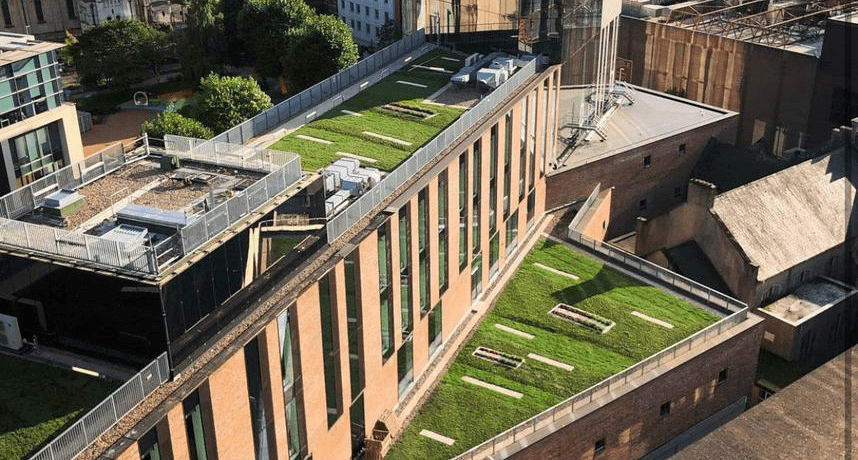
7.0 Some misunderstandings about SuDS
7.1 Misunderstandings
7.1.1 Since SuDS were first introduced to the UK as a new way of managing runoff they have been met with resistance to change. Numerous misunderstandings have developed over the intervening years. It is important that we understand the reality of SuDS based on evidence, and experience with well designed SuDS.
7.1.2 Many misunderstandings that have built up over the years are largely due to the lack of experience of using these types of systems. In other parts of the UK, the number of misunderstandings are reducing as designers, developers and local communities get used to seeing SuDS as part of development and appreciating the wider benefits that they contribute.
Aerial photograph of Robert Welch warehouse showing permeable carpark and raingardens.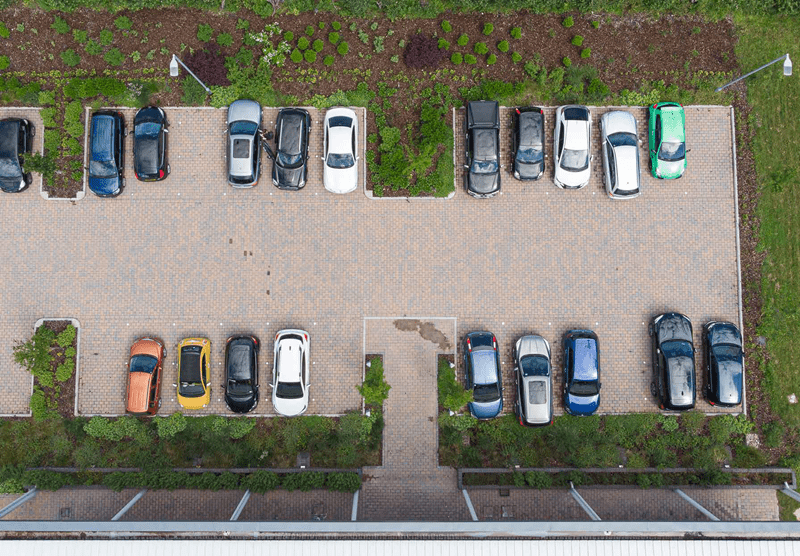
| Misunderstanding | Review of the evidence |
|---|---|
| There is no space for SuDS – they are land hungry | SuDS do not require additional space and can be incorporated into developments at any scale. It has been demonstrated that integrating SuDS into the fabric and amenity space of any scale of development enhances their character. |
| Belfast is covered in clay – SuDS require infiltration to work | SuDS mimic natural drainage, therefore if they are located on clay surfaces, water will runoff the surface as it would have done in the natural catchment. SuDS only use infiltration where there is suitable ground to infiltrate. |
| You cannot construct SuDS on contaminated ground. | SuDS offer potential significant advantages over conventional drainage on contaminated sites. By keeping features at or near the surface we can minimise the need for excavation or the removal of contaminated soils (whilst ensure that any proposed SuDS are compatible with any required remediation measures). |
| Risk of drowning | SuDS are usually shallow with temporary storage of water. They are designed for ease of entry and exit, with shallow side slopes allowing people to get in and out, and bring amenity and wildlife benefits to development. |
| SuDS are expensive | All UK evidence collated to date confirms that well designed SuDS are less expensive to construct than conventional drainage. Further consideration is given to the cost of SuDS in Appendix A. |
| Permeable pavements will quickly clog | There are numerous examples of permeable pavement across the UK installed over the last decade with no loss of performance. Everyday care is surface brushing with long term refreshing of the surface a simple grit joint replacement. Experience from elsewhere in the UK is indicating that this may only be required after 15-20 years of use. |
| SuDS are difficult to construct and maintain | SuDS are different – not difficult. Most SuDS require no more than general landscape maintenance. |
8.0 Designing SuDS
All hard surfaces need to be drained for the convenience of people. Conventional piped drainage uses a change in level to direct runoff to a gutter and drain opening where water enters a pipe and disappears from view. Local flooding often occurs because heavy rainfall, especially during intense summer storms, cannot enter a pipe when gully pots are overwhelmed or because the opening is blocked. SuDS are different to conventional drainage in that they appear at the surface and form part of the development, but are not difficult to integrate into site layouts if considered at the start of the design process.
“SuDS are different, not difficult”
8.1 Introduction to SuDS design
8.1.1 SuDS are designed to collect runoff efficiently from hard surfaces in a variety of ways, but instead of the water being piped away as quickly as possible, it is held locally so that it can be cleaned, stored and contribute to our wellbeing before making its way slowly towards the sea.
8.1.2 This change in approach means that SuDS must be considered at the beginning of the design process to ensure that SuDS features can be integrated into the site layout to deliver not just effective drainage but also wider social and wildlife benefits.
8.2 SuDS Design concepts
8.2.1 Well-designed SuDS will generally demonstrate a number of common characteristics.
Keeping runoff at or close to the surface.
8.2.2 Conventional drainage collects water in gratings and channels, often using the gully pot to trap grit and heavy oils, with water piped away underground through pipes to treatment works or directly to the river. There is no chance to clean the water, reduce the risk of flooding or gain any benefit locally from the rain. Runoff can be collected in a range of SuDS features which keep water at or close to the surface.
8.2.3 Roof water usually directly enters the pipe system underground, but in SuDS is often collected at the surface in attractive landscape features that introduce visual interest to the development.
A ‘shoe’ fitted to a rainwater pipe at the Robert Welch Warehouse, discharges into a paved channel leading to a raingarden.
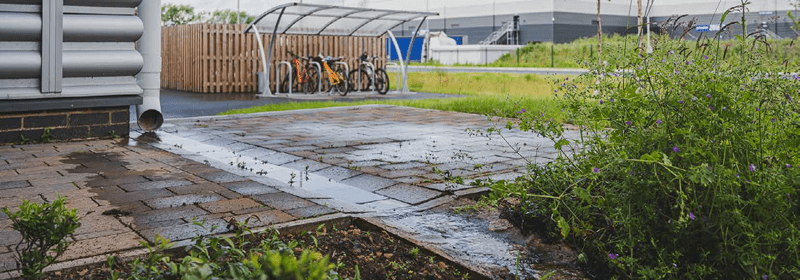
Providing source control as soon as runoff is collected
8.2.4 Holding water close to where rain lands on the development allows SuDS features to trap the pollution immediately as it washes off hard surfaces, reducing the rate of flow and encourages clean water to soak into the ground or evaporate into the air. This is called ‘source control’ and begins the process of natural losses of water that occurs in nature and helps protect places and people downstream.
Building a management train
8.2.5 Linking SuDS in a series of features called ‘the management train’ provides effective storage and cleaning of water throughout the site. It begins with source control with SuDS features linked through conveyance of flow along the surface in hard channels or grassy swales to other SuDS features. Although pipes can be used if necessary, for example where a crossing of highway is required, they can increase the depth of drainage from the surface meaning that the opportunity for surface SuDS features downstream may be lost.
ENV5 encourages two stage SuDS management train to be used in order to improve quality
Splitting the site into sub-catchments
8.2.6 Conventional drainage usually pipes all the runoff from development to a single storage location, often referred to as a ‘pipe to pond’ or ‘pipe to tank’ solution based on the old idea of the ‘balancing pond’. This practice misses all the benefits of the SuDS approach and often results in expensive below ground storage of dirty water with no benefits to the community. Dividing a development into small, discrete drainage areas called sub-catchments is the way to manage runoff locally and integrate SuDS throughout the development. The sub-catchment approach is more resilient, easier to manage and usually cheaper than the conventional drainage solution.
8.3 Designing for the benefit of the community
8.3.1 SuDS brings water back to the surface for the benefit of the community and wildlife. This is what we see and experience. Where opportunities are taken to integrate SuDS as part of the development, SuDS can provide tangible benefits to the community.
8.3.2 SuDS introduce many other benefits to the community and can be particularly beneficial in the middle of cities where there is a lack of existing green space. There are a wide range of benefits associated with SuDS.
- Provide natural cooling to combat the heat island effect.
- Improvement in air quality.
- Contribute to health and wellbeing.
- Reduction in combined sewer overflows.
- Provide climate resilience.
- Help address local flood risk.
- Use as an education resource for schools and general public
8.3.3 These wide-ranging benefits are associated with SuDS features which also contribute to delivery against ‘Policy GB1 – Green and blue infrastructure network’.
8.3.4 All places that are accessible to people should be attractive, useful and safe. In the same way that careful design minimises the risk of vehicles to people, careful design is necessary where water is present in the landscape and changes of level may be expected. Water features are common in the modern city design and SuDS can contribute further opportunities to experience water in different ways.
This play area at Springhill Co-housing also manages runoff - but only in extreme events.
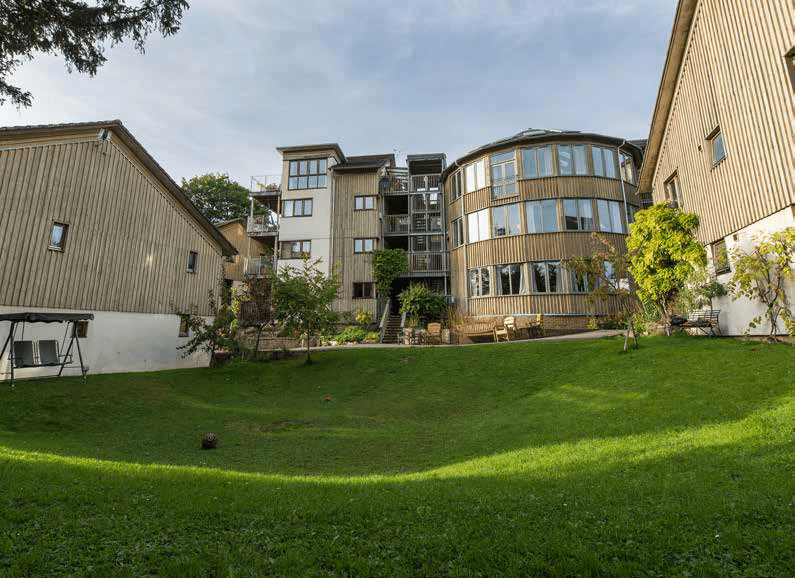
This wildlife pond at Springhill Co-housing is at the heart of the development and creates character.
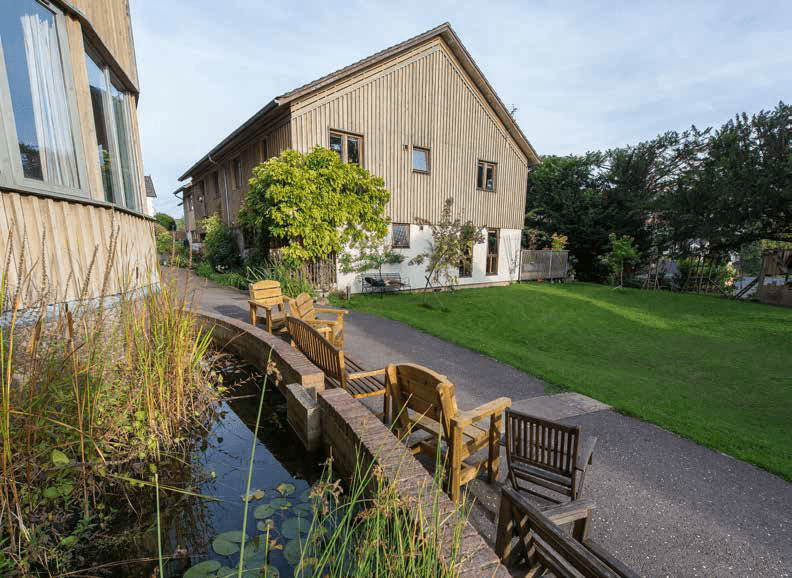
SuDS allows us to re-connect with rainfall by managing water in visually exciting landscape spaces that are safe and environmentally friendly for everyone
8.3.5 SuDS features will provide interest and opportunity for all age groups. Careful consideration is required by designers when assessing risk from temporary or permanent surface water SuDS features as they may be avoided due to an overly risk adverse approach. The Royal Society for the Prevention of Accidents (RoSPA) has identified that open water SuDS features are no more dangerous than the ones that we find in our natural landscapes and should be designed to be ‘as safe as necessary not as safe as possible’.
8.3.6 The clean water provided by SuDS can flow attractively in shallow channels from one place to the next as they did in many older cities and towns. Water may be stored by increasing the depth of water in wetland and ponds for short periods or filling normally dry basins in open space for short periods. The stored water should always be shallow with careful edge design to prevent accidental falls into water.
Children at Clandeboye Primary School interacting with the SuDS feature.

8.4 Designing for flood resilience
8.4.1 Local flooding often occurs because heavy rainfall, especially during intense summer storms, cannot enter a pipe when gully pots are overwhelmed or blocked. SuDS features have much greater capacity to accept runoff from these larger storms and are less prone to blockage. The water is held locally before being releasing slowly which helps protect downstream drainage networks and property.
8.4.2 SuDS are designed to include overflows and exceedance pathways that work when SuDS features are full. Exceedance flows are managed in predefined routes that help protect local communities from localised surface water flooding.
Inlet from road into a raingarden.
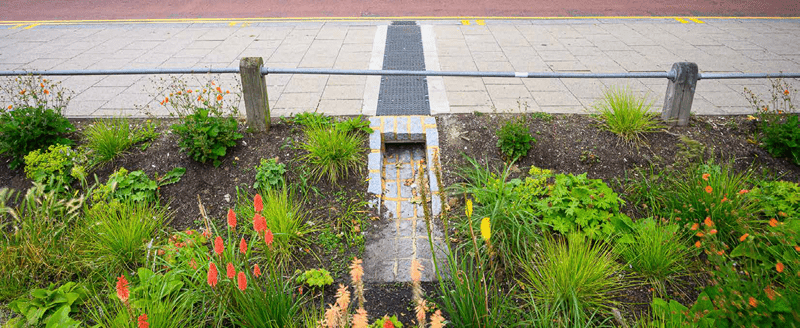
9.0 SuDS - A range of features
9.1 Components of SuDS
9.1.1 SuDS still drains roofs, pavements and roads when it rains, but instead of conveying water away in pipes, it collects runoff in physical structures (referred to as SuDS features but also called SuDS components or SuDS measures) that are part of development.
9.1.2 Some SuDS features, like green/blue roofs and permeable paving, do not take up space as they are part of the development footprint and are ideal in dense urban locations where useable space is at a premium. Other features like swales, basins and ponds contribute to green infrastructure and create healthy surroundings for people and wildlife.
9.1.3 In practice, the scale of a SuDS scheme may range from a single water butt, a domestic raingarden, a free draining permeable car park to a multi-sub-catchment SuDS scheme on larger development.
9.1.4 Not all SuDS features will be suitable for every site and various factors such as the amount of greenspace available, type of development, topography and geology are likely to influence selection of SuDS features.
The Robert Welch Warehouse demonstrates how a variety of SuDS features can be used within a development to provide different appearances, functions and biodiversity benefits. Permeable paving, raingardens, raised wetlands, swales, meadow basins and biodiverse wetlands have been used here.
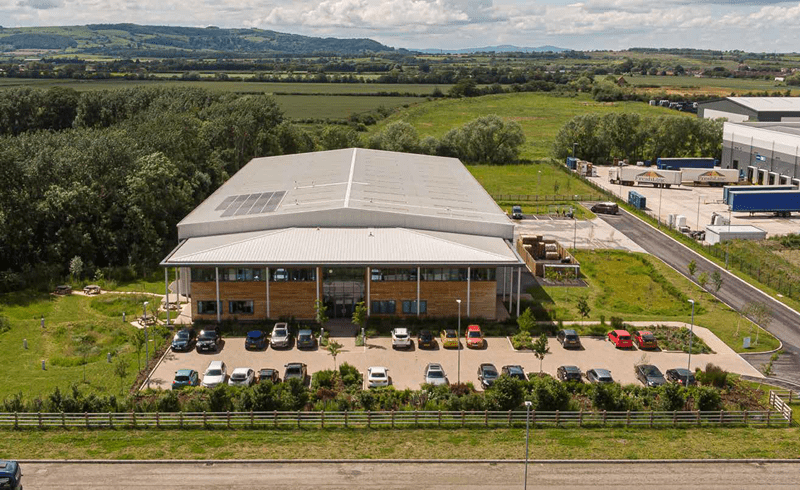
Green and Blue Roofs
9.1.5 A green roof is a roof or deck of a building that has vegetation and a growing medium, planted over a waterproofing membrane. Rainfall can be temporarily held on the roof with the use of a flow control. A green roof that stores rainfall temporarily before releasing it slowly is referred to as a blue roof.
Blue and green roofs are important in highly urbanised areas where the footprint of a development can be taken up entirely by roofed areas.
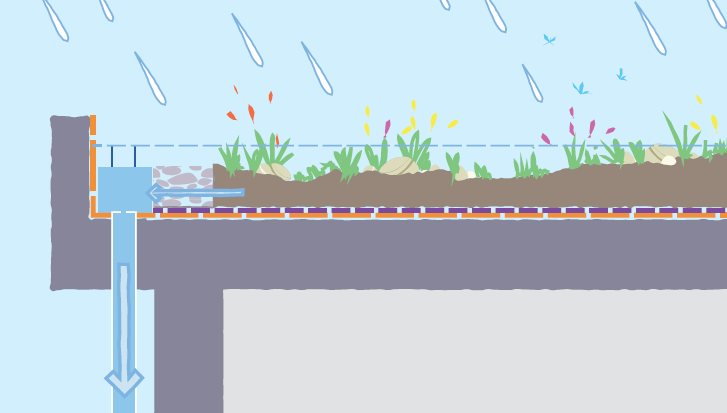
Recently constructed Green roof at a sports facility, Glengormley.
Raingarden
9.1.6 These shallow planted basins originally designed for gardens, are now being used in public green spaces to manage reasonably clean water from roofs or lightly trafficked hard surfaces. They can take many forms but usually collect everyday rainfall with an overflow connection back to the sewer. Typically designed to receive runoff from roofs and non-trafficked hard surfaces, they are normally sized to only hold water for a short period of time, emptying for the next time it rains.
9.1.7 The idea of the raingarden is now being used in many non-garden locations such as taking runoff from school roofs. Planting can be like a flower garden but with other planting styles e.g. wildflower meadows.
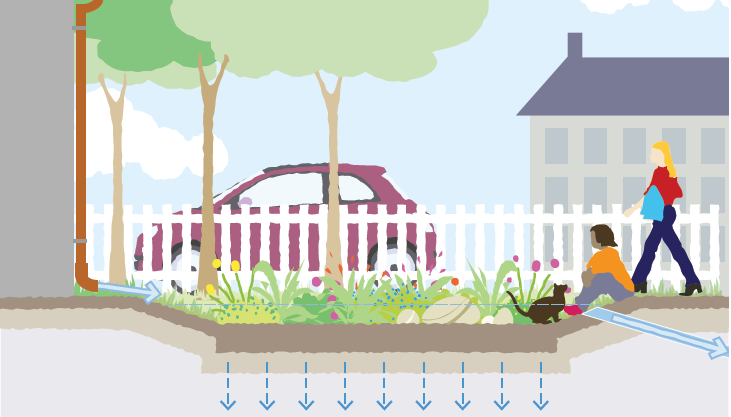
A raingarden next to a new science block.
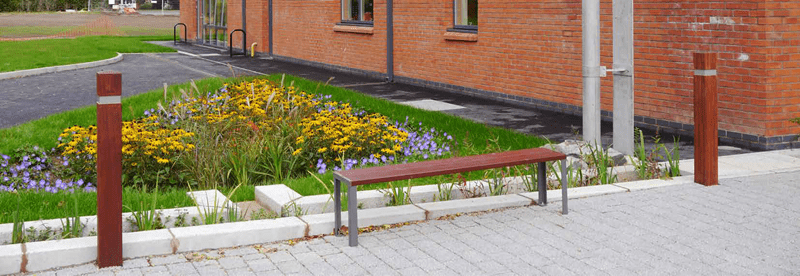
Rain planter
9.1.8 These are a variation of a raingarden, but can be very effective in higher density situations such as city centres, where the fabric of development is mostly hard landscape. They can be used in retro-fit situations where downpipes are disconnected and diverted into the rain planter.
9.1.9 An overflow into a drain or another SuDS feature is recommended as it is rare the planter alone will cope with rainfall from a heavy storm.

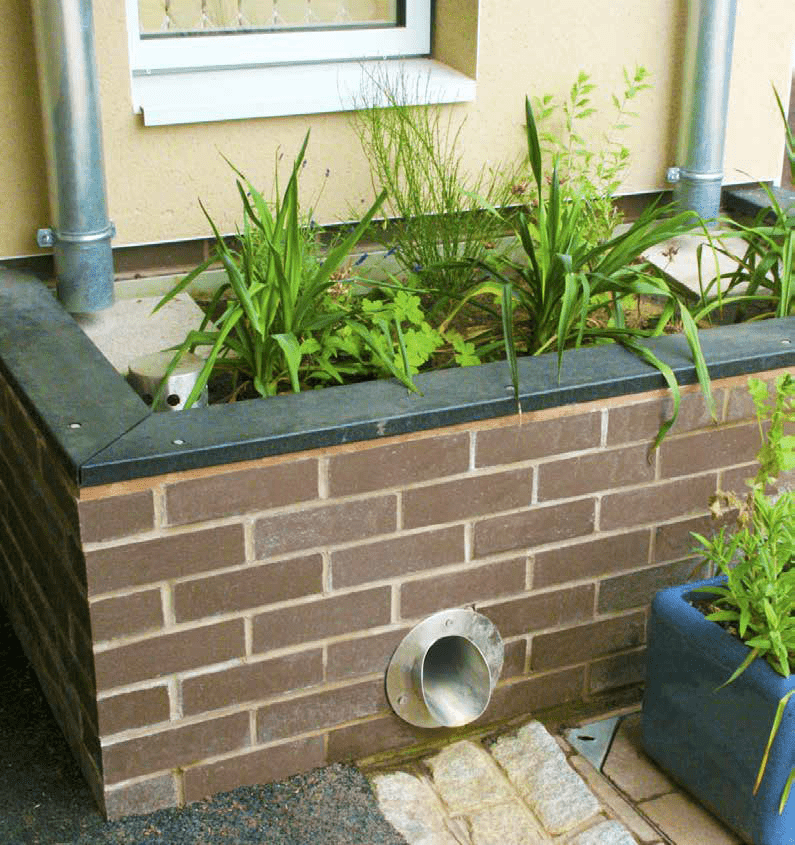
A small rain planter at Vauvert Primary School.
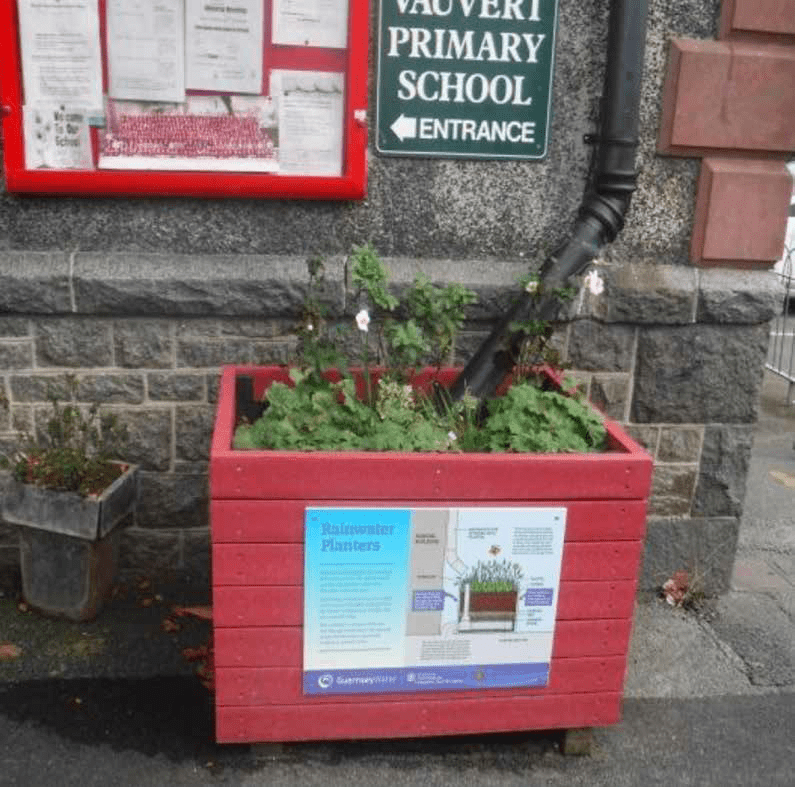
SuDS tree pits
9.1.10 SuDS tree pits are designed to collect runoff from the surrounding landscape. They can be integrated into both new development and urban renewal enabling large trees to thrive by being watered every time it rains. Healthy trees also need sufficient soil to grow and this growing medium can also be used to store water before being released slowly to the next part of the drainage system.
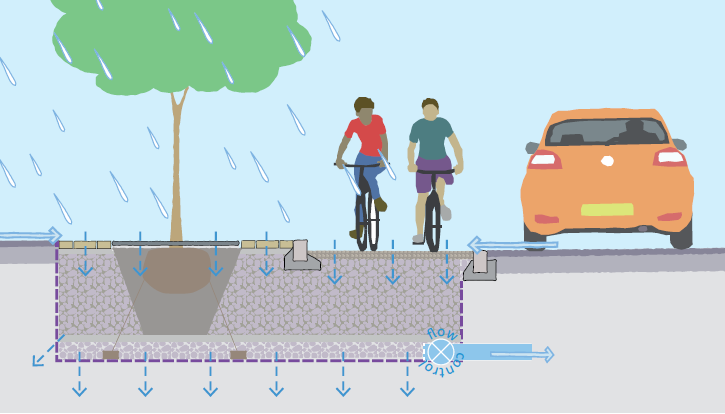
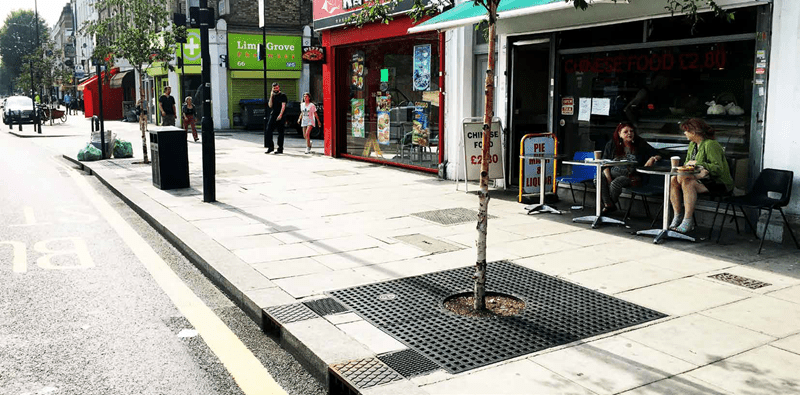
Bioretention Raingardens
9.1.11 This SuDS component can look similar to a simple raingarden but differs in that the profile includes a free draining soil with a drainage layer at the base to drain the feature. This additional cleaning of water by bioretention features is useful in road design as they retain heavy metals and break down oils, hydrocarbons and other organic pollutants. The more formal appearance of bioretention features can fit with and contribute to the urban street character.
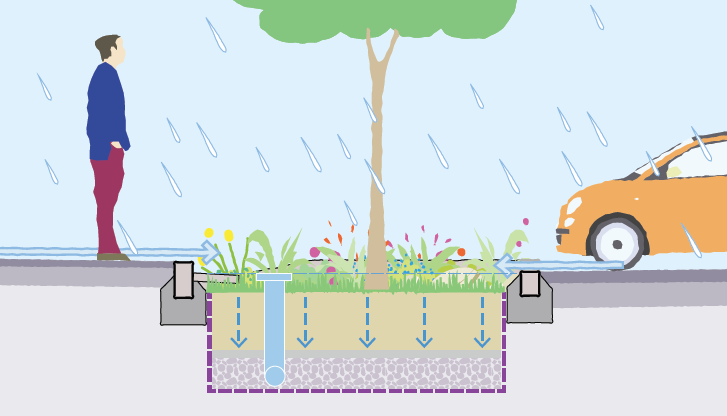
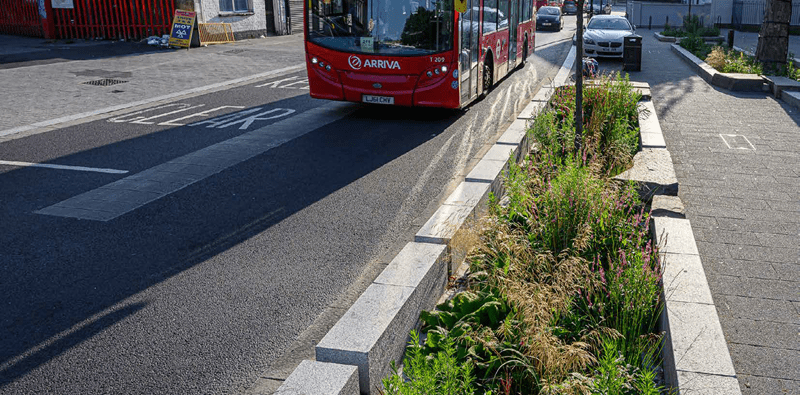
Permeable surfaces
9.1.12 Permeable surfaces allow water to pass through the pavement surface into crushed stone below rather directly than into drains. Water is cleaned as it filters through the crushed stone and stored in the gaps in between the stones. During rainfall the stone layer fills with water and either soaks into the ground or is released through a flow control.
9.1.13 One of the most common types of permeable surfaces is concrete blocks that are separated by an open joint filled with grit. Permeable block paving is particularly useful for car parks and courtyards where traffic speeds are slow and pollution by heavy metals, oils and tyre waste is common. UK experience over the last 20 years indicates that maintenance of the pavement is not an issue.
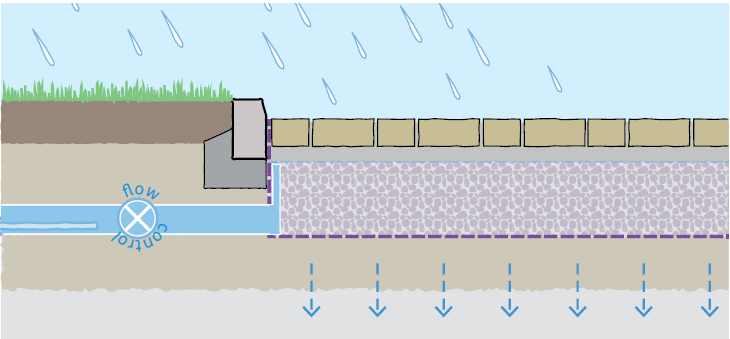
Filter strips
9.1.14 Filter strips are grass surfaces at the edge of pavement resembling a grass verge. They allow water to flow horizontally through the grass to another SuDS feature, filtering the runoff at source. The grass is kept at about 100mm to filter the runoff but is otherwise like amenity grass.
Filter strip between road and raingarden.
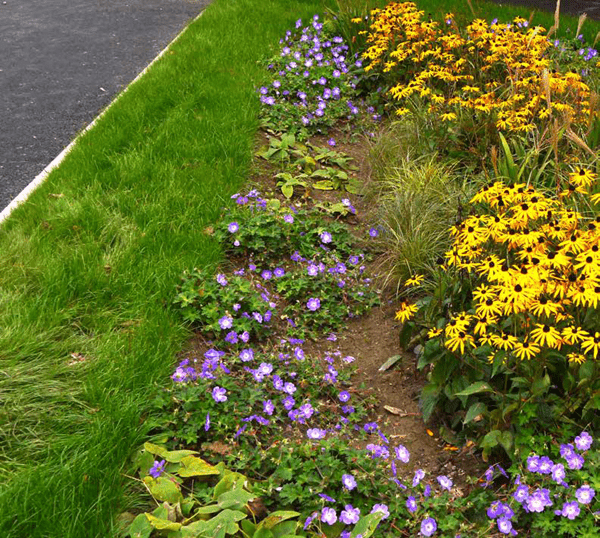
Swale
9.1.15 Swales have a similar appearance to ditches but differ in that they are shallow with a flat grassed base. Swales can deal with extreme rainfall, but also filter runoff as it passes through the vegetation providing a stage of treatment. Swales can be designed as biodiversity corridors and can be planted with wildflower meadow mix for a more visually interesting appearance.
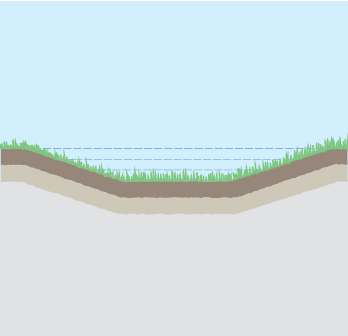
Swale with tree planting at a School.
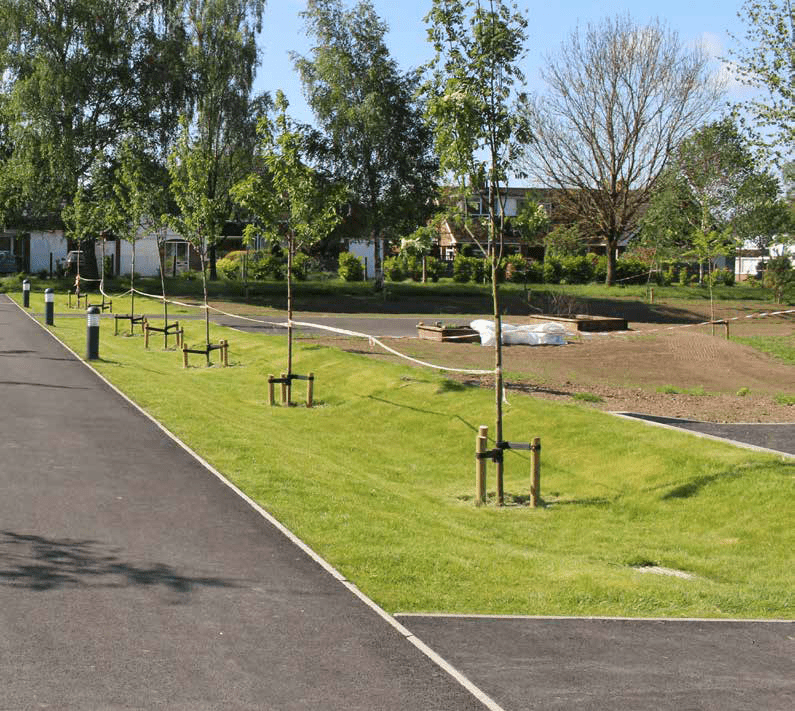
Filter drains
9.1.16 Filter drains, sometimes called a French drain are open stone filled trenches. Filter drains can either have an open stone surface or can be combined with a swale profile to create an under drained swale. They have been extensively used on road schemes throughout UK and also within housing layouts (under the base of a swale) to ensure grass surfaces remain dry and useable most of the time.
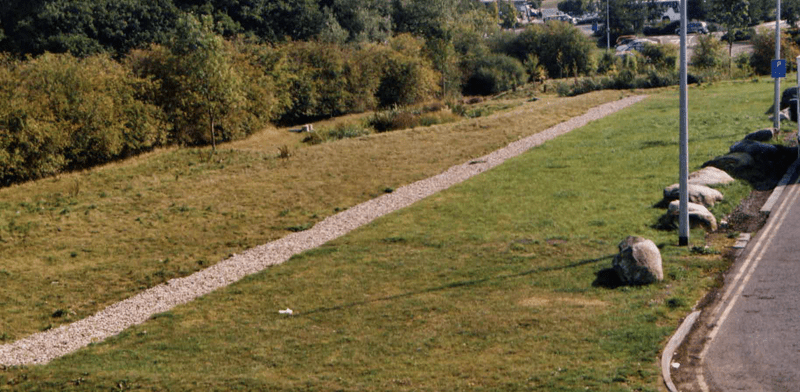
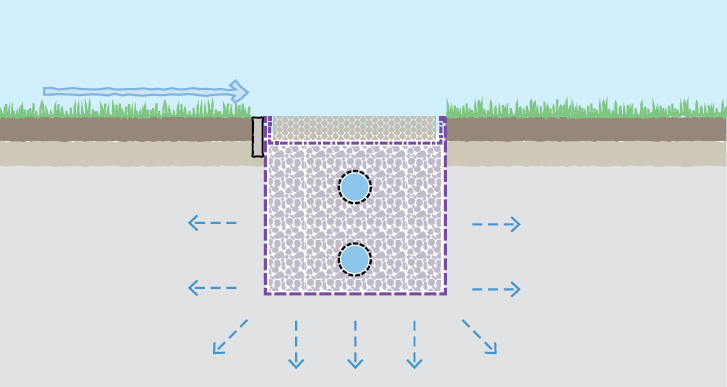
Basins, wetlands and ponds
9.1.17 There green space is available or amenity areas can be used occasionally to store water then grassy basins, ponds and wetlands are a cost effective way of managing rainfall with benefits for people and wildlife. SuDS basins, ponds and wetlands should be shallow to appear natural in the landscape and present minimum risk to the public.
9.1.18 Where enhanced biodiversity habitats is preferred, ponds and wetlands can be introduced which will include different plant varieties and presence of permanent water. These features can be designed into all types of development, even high density residential development.
Photo of Clandeboye Primary School pond.
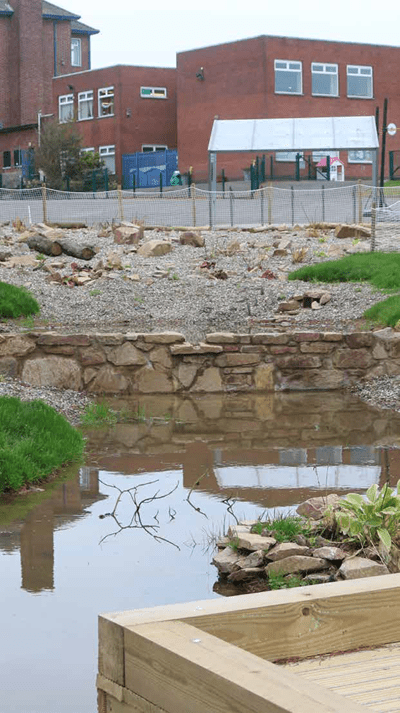
Underground storage structures
9.1.19 Where runoff is temporarily held in large underground structures, this is generally in the form of oversized pipes or plastic geocellular tanks. Underground storage, where it is required, can be protected from silt ingress by providing surface based SuDS features upstream to remove silt before it enters the storage.
9.1.20 Solely providing piped collection of runoff in a pipe network along with underground storage should not be confused with providing a SuDS approach and does not meet the aspirations of providing a two stage treatment process (ENV5).
9.1.21 Designers are referred to the SuDS Manual C753 Section 21.1 for further detail.
10.0 SuDS for every location
SuDS can be used on every size of property, from an individual home to the largest housing, commercial and industrial development. Eventually this ‘controlled flow of clean water’ flowing from development will play its part in enriching the natural surroundings that create a healthy environment for us all.
10.1 SuDS for the home
10.1.1 The smallest house can use SuDS features to manage rainfall in an environmentally friendly way.
10.1.2 The cleanest runoff, when it rains, is from the roof. A rainwater butt, particularly if its emptied regularly, is the simplest form of rain-harvesting. Rainwater butts can reduce the impact of heavy rainfall, particularly in summer, when butts are more likely to be used regularly. As well as reducing the risk of flooding rainwater butts can also reduce the demand on the water supply system and can be a useful resource during hosepipe bans.
10.1.3 Although green/blue roofs are not suitable for most sloping roofs, they can be used on flat roof extensions, garages and garden buildings creating ‘elevated gardens’ or gardens in the sky. Even green roofs, with no flow control, catch the first part of rainfall that soaks into the soil, mimicking the interception losses that occur in natural catchments.
Example of a small green roof - Image: courtesy Dusty Gedge

10.1.4 New driveways or outdoor terrace areas and courtyard gardens can be made permeable to allow rain to either soak slowly into the ground by using permeable paving or gravel as a surface and planting spaces to add interest to the space.
Permeable paving used in a residential car park.
10.1.5 Roof downpipes can be disconnected and diverted to permeable surfaces or into a raingarden. The raingarden character can take many forms, a flower garden, a ‘biodiversity’ meadow garden or even a gravel garden that allows some water to soak into the ground. The main thing is that the raingarden fits in with the character of the house and the owner is comfortable with the idea of it.
Overflow from a rainwater butt diverted into a nearby raingarden.
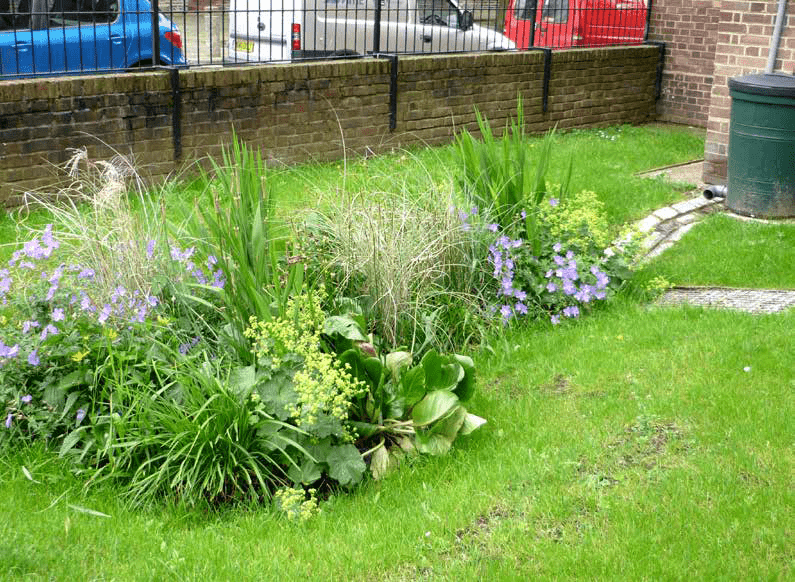
A de-paved front garden in Greenwich. Image courtesy of Owen Davies.
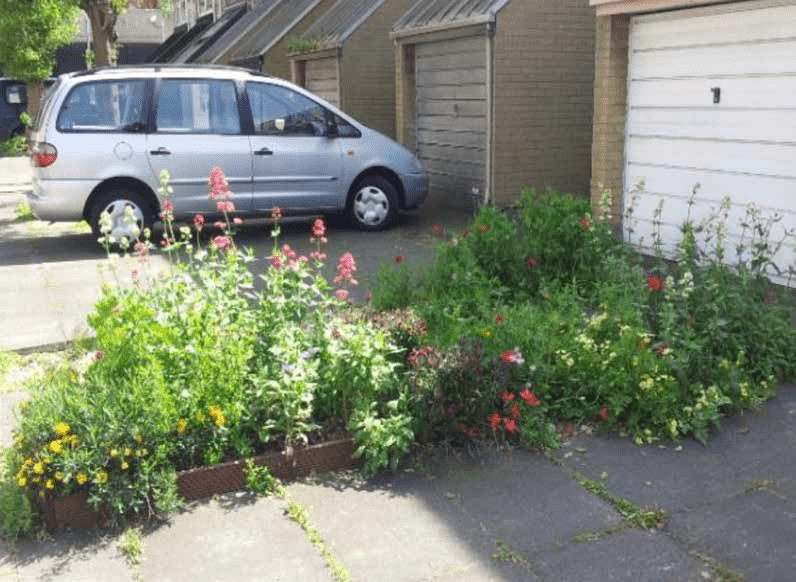
10.1.6 De-paving any unnecessary existing hard surfaces and replacing with a soil or porous surface will help reduce the risk of flooding in the wider catchment.
10.1.7 These are ways the individual house can display many of the SuDS features that are used on larger developments and demonstrate how easily they can be integrated into everyday living.
10.2 SuDS in housing developments
10.2.1 SuDS can collect, clean and store water on larger housing development in a similar way to individual properties but use a more communal approach where SuDS features serve multiple properties. SuDS features can be designed to be a focal point of the development to be enjoyed by the residents.
10.2.2 Urban housing is dominated by roofs to buildings and hard surfaces at ground level. In the city centres such as Belfast, urban green/blue roofs and permeable pavements are simple ways to collect, clean and store rainfall that do not require any additional space.
Residential biodiverse green roof. Image courtesy of Urban Green Artists Ltd.
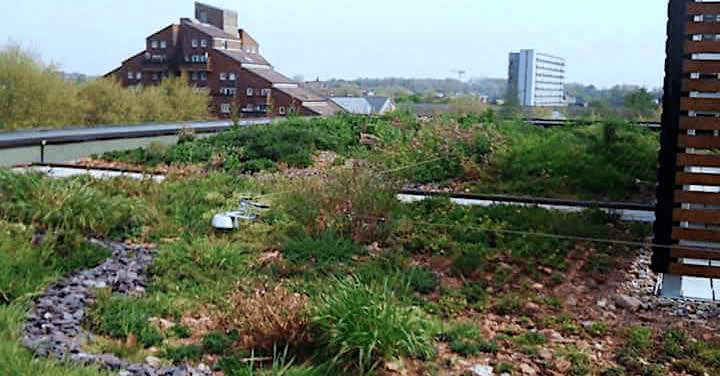
10.2.3 Where there is urban green space it should always be considered for managing rain. It is important to note that each SuDS component does not have to be sized to manage extreme rainfall. Each bit of storage from all features can count towards the overall storage required for the site.
10.2.4 Small SuDS features like ‘raingardens’ can normally be sized to deal with small day-to-day rainfall, whereas blue roofs and permeable pavement are generally capable of storing much larger quantities and can be sized for more extreme rainfall.
Raingarden with rainsculpture at Bridget Joyce Square.
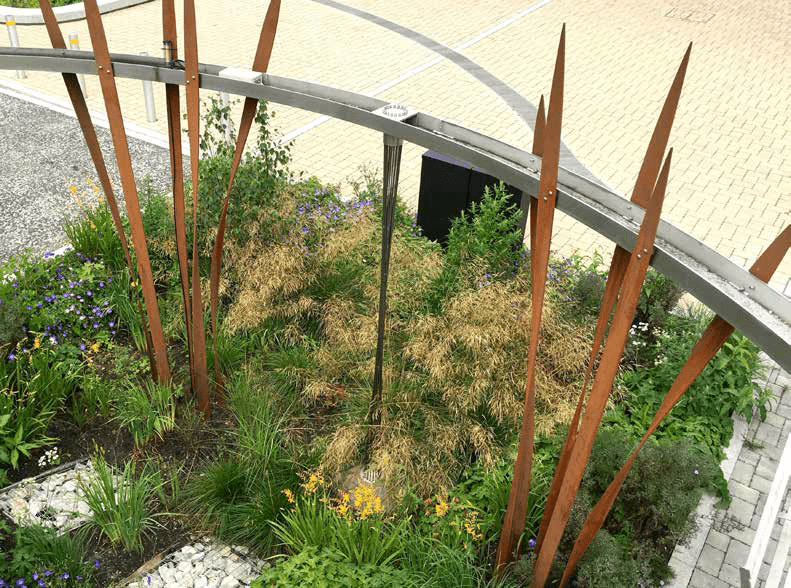
Wetland planted rill at Bewdley School.
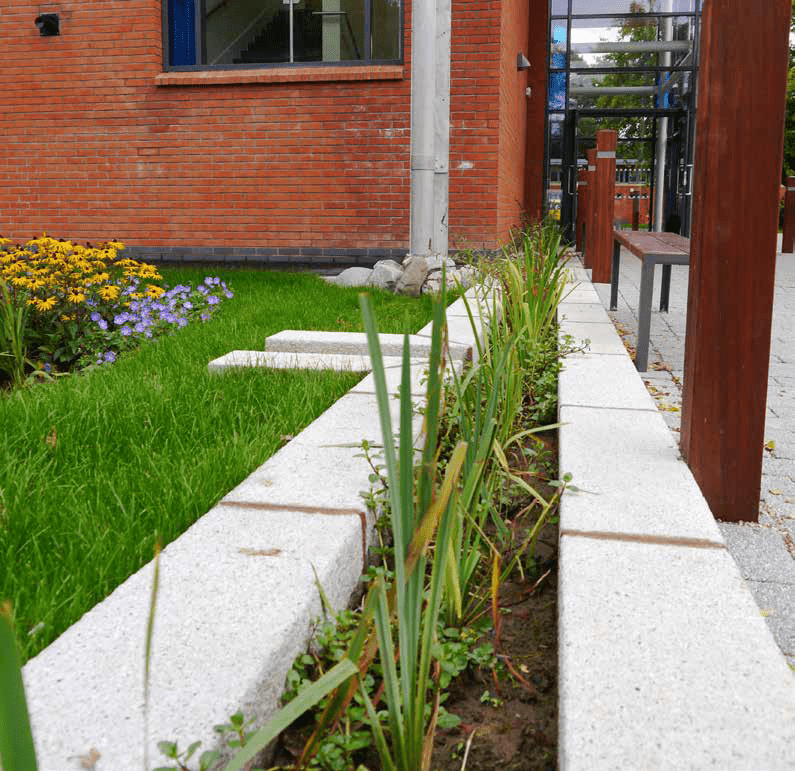
Rill at Malmo.
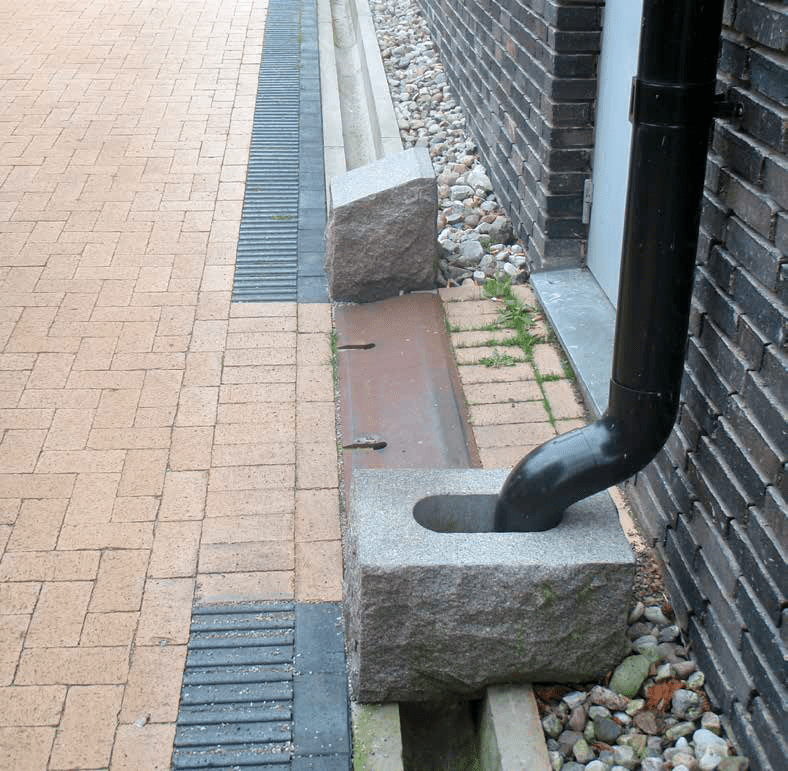
10.2.5 Water can stay at the surface both when it is stored for short periods or when it flows from one place to another. Pipes may be used to link one SuDS feature to the next but should not comprise a large part of the drainage system.
10.2.6 Suburban housing may be less dense and therefore have more space than the high density housing developments.
10.2.7 The space around houses and in the open green areas around suburban housing allows a more expansive range of SuDS features to be used to manage rainfall.
10.2.8 Verges that are often used to separate roads from paths or houses can easily become filter strips or shallow swales that both collect runoff from roads and take it to an open storage basin, wetland or pond. The grass in the swale filters the runoff and traps silt ‘at source’. Water can either flow across surface channels to the next part of the SuDS or be collected in an ‘under-drain’ below the grass surface and connect to another SuDS component.
This verge was modified to receive and contain road runoff beneath mature trees.
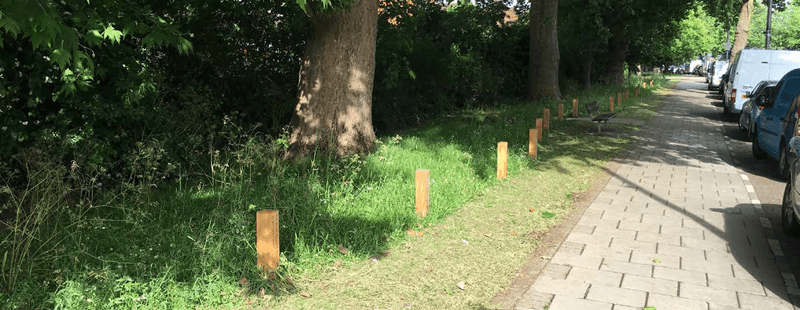
10.2.9 Alternatively, rainfall can be collected using permeable paving in areas that are trafficked including driveways, parking spaces, low use areas such as cul-de-sacs and courtyards commonly found in modern housing layouts. This is a particularly useful method of trapping pollutants caused by vehicles.
Permeable road in a housing development in Newtownabbey.
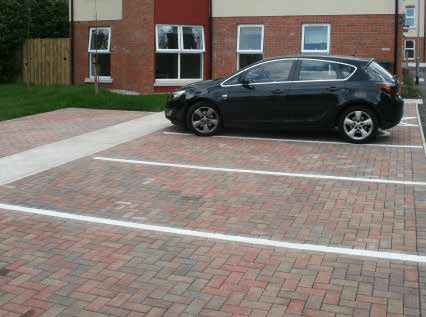
Permeable road in a housing development in Bangor.
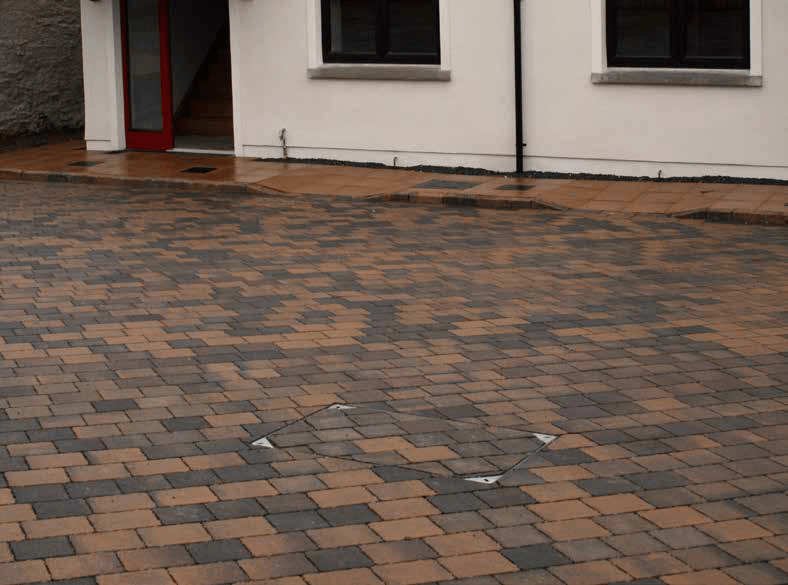
10.2.10 Source control features like permeable paving, green/blue roofs, filter strips, filter drains and swales all clean the polluted runoff in housing development so that it can be stored in open basins, wetlands or ponds for the benefit of people and wildlife.
10.2.11 By storing water in smaller volumes throughout the site as part of integrated site design, the volume that has to be stored in the final SuDS storage feature (prior to slow release to the watercourse or sewer) can be greatly reduced. Through integrated design SuDS specific land take can be minimised.
This SuDS basin is gently sloped and has a low flow channel so that it is useable amenity space in all but extreme storms.
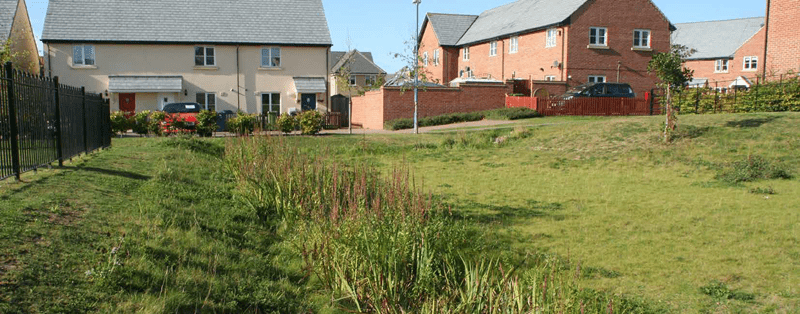
10.2.12 These features will become more common in the future as SuDS is accepted as a better way to manage rainfall. The experience from housing where SuDS has been used is that residents like the SuDS features and understand both the need for SuDS and how it works.
10.3 Helping to green the City
10.3.1 The centre of towns and cities can be challenging sterile landscapes for people with little green space, poor air quality and a sense of separation from nature. SuDS can help improve these highly urbanised areas in a number of ways.
10.3.2 Although the historic centre of cities may not change dramatically many parts of the urban scene are being re-invented all the time. The last decade years have seen a dramatic rise in the use of roof top space in Belfast is liveable space and commercial enterprise.
Rooftop garden/terrace at Bullitt Hotel, Belfast.
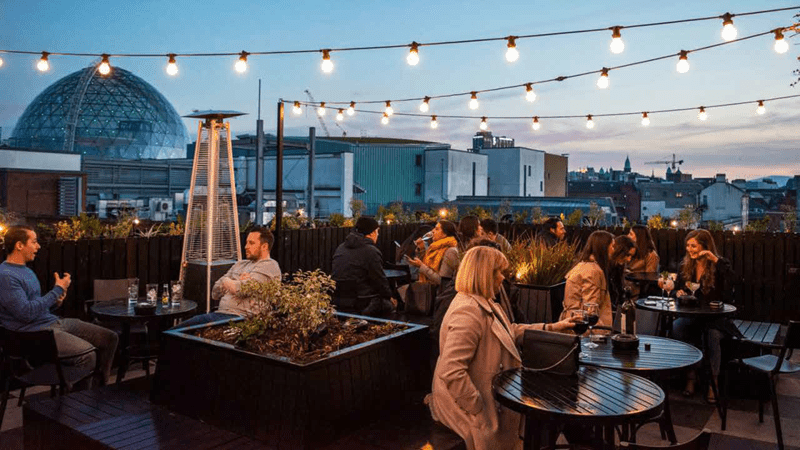
10.3.3 A change in the way we see roof design can also be an opportunity to keep water at roof level when it rains. Ideally this should be as green/blue roofs but any flat roof can collect rainfall and hold it back for short periods by controlling the rate it is released to the sewer. Whilst managing rainfall, the roof can also be used for other amenity functions / living space and it is possible to creatively combine these functions to the benefit of those who use this space. Image: courtesy Bullitt Hotel
10.3.4 Initiatives to ‘green’ cities should always consider managing rainfall. Urban tree planting is an opportunity to use SuDS to ensure trees grow well and have enough space for root growth. Runoff is directed to tree pits or planting trenches that are designed to collect, clean and store the water before it flows onward to pipes or watercourses.
Cut-away diagram showing components of a SuDS tree pit.
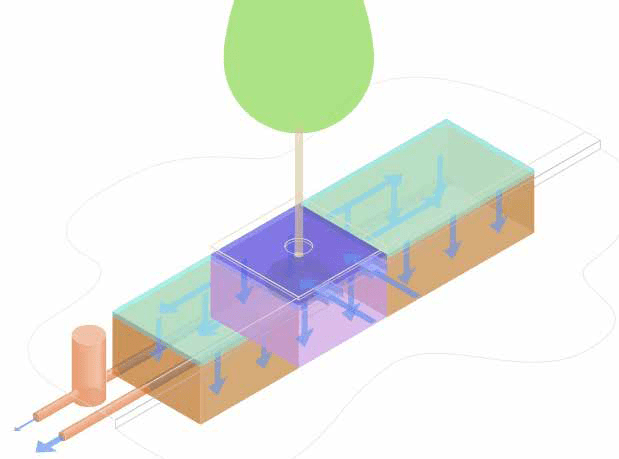
SuDS tree pit supporting paving by using a structural soil system
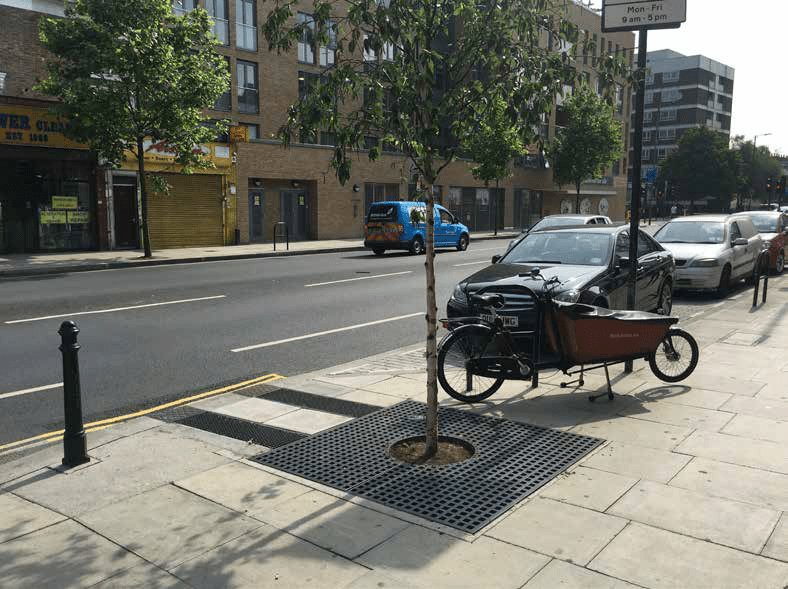
10.3.5 Bioretention raingardens can be used in city streets to collect and clean road runoff and can be integrated with urban social space to create better places for people in the city.
10.3.6 Green space can contribute to managing urban runoff by simple changes in planting design. Highway and roof runoff can be diverted into these spaces. A sequence of ‘raingardens’ can add interest and biodiversity to green space and particularly in summer irrigate the park landscape when it is dry rather than letting the rain go down the drain.
Raingarden at White Hart Lane.
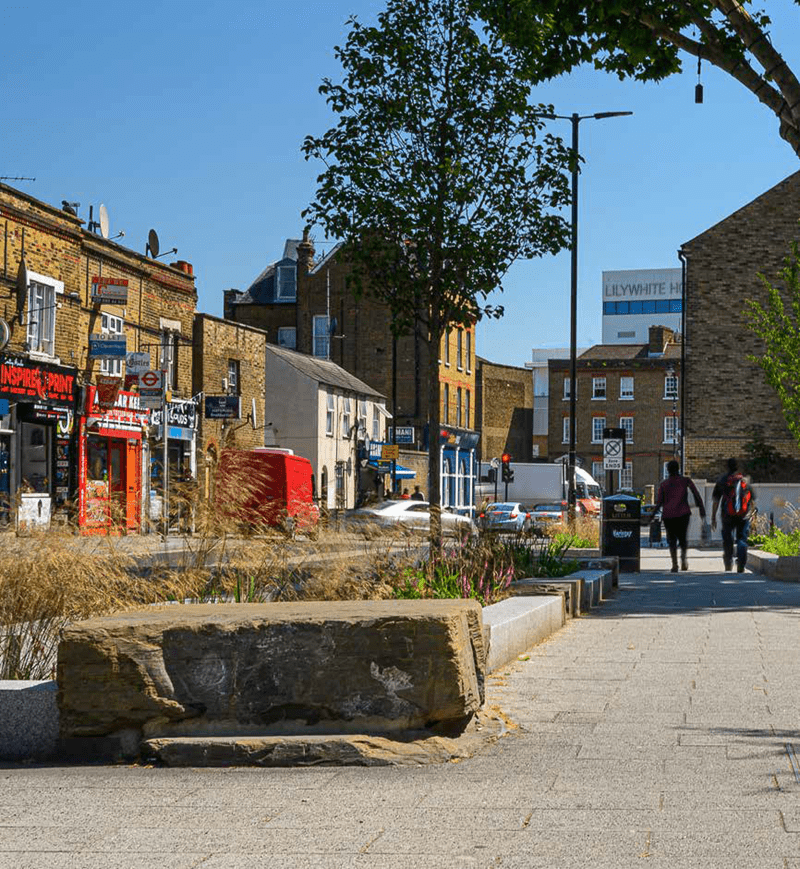
Raingarden at Crescent Gardens park.
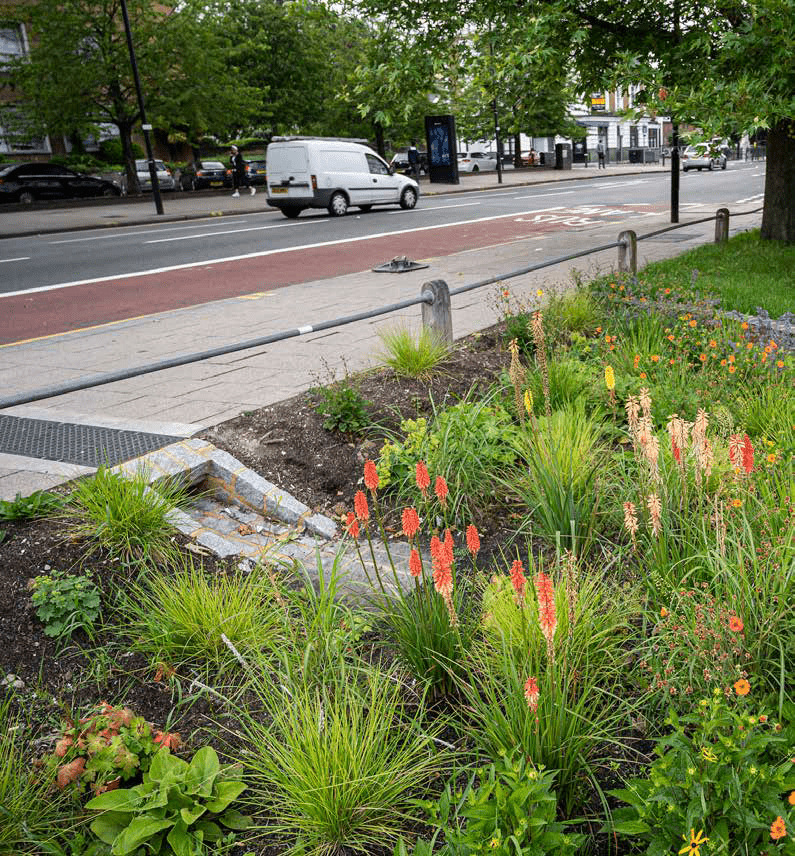
10.4 Commercial development
10.4.1 Some commercial properties will be part of the general urban fabric of the city and the SuDS approach to them will be the same as for the city centre in general.
10.4.2 However, some commercial and leisure uses may be located outside the city centre, often in lower-density settings that are characterised by large building footprints and extensive areas for access and parking. These large expanses of hard surfaces, both roof and car parking with access roads, require a fresh approach to managing rainfall.
10.4.3 The light-weight nature of the long span roofs in many commercial and industrial units is unlikely to be suitable for green or blue roofs. Where planters and green space are present these can be considered for SuDS functionality. Use of permeable pavement in carpark areas provides opportunity for treatment and storage of significant amounts of rainfall.
Permeable paving at a car dealership in Dungannon

Meadow basin at Robert Welch warehouse.
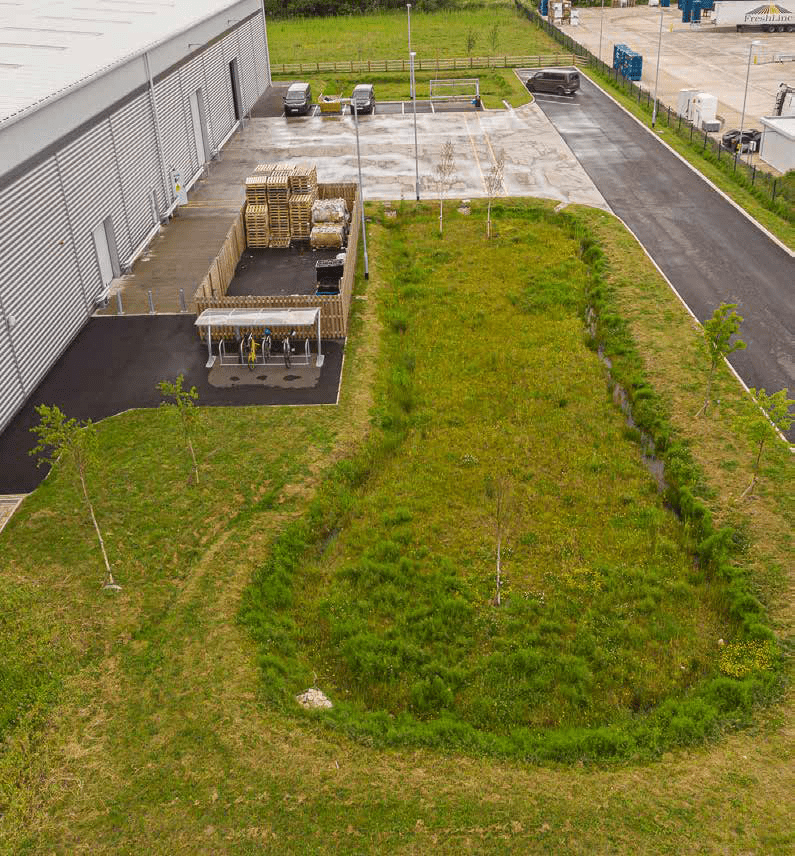
Courtyard using permeable pavement off Adelaide Street.
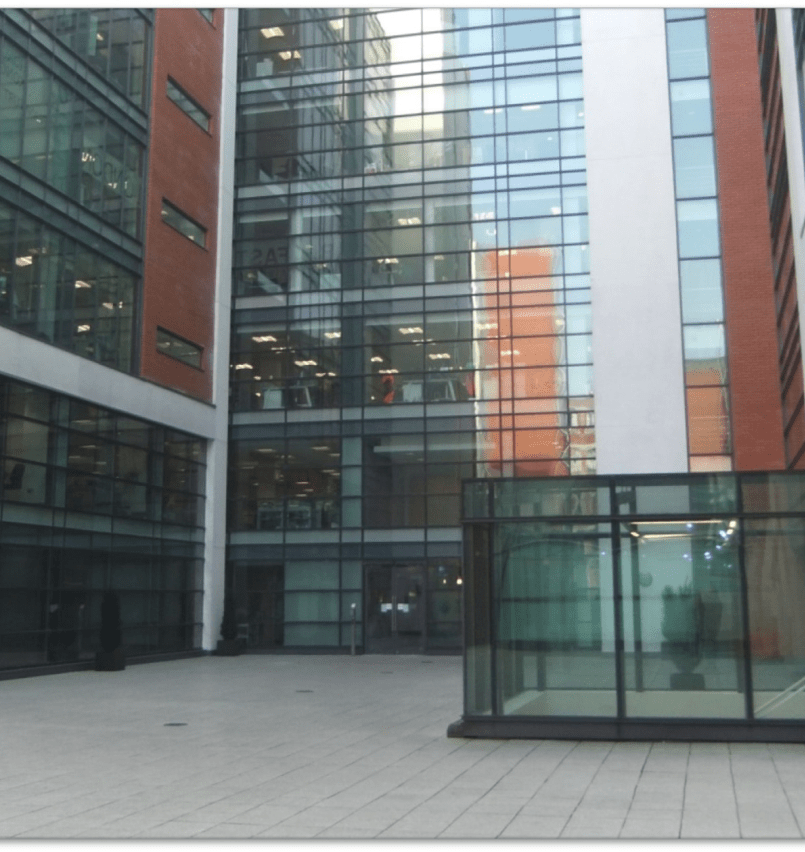
10.5 The public realm – SuDS and people
10.5.1 Whenever people are outside they experience rain. Usually this is an uncomfortable or inconvenient experience. We are used to seeing rain as a nuisance rather than as a resource and/or as a way to animate a space and create visual interest.
10.5.2 SuDS, when well designed, overturns this perception by collecting water in interesting ways, forming interesting landscape features, creating a home for wildlife and re-connecting us with nature and instilling a sense of wellbeing.
10.5.3 There are now many SuDS schemes that achieve much more than the basic need to drain hard surfaces to get rid of the rain. Through the use of SuDS as part of an integrated design approach, we can realise benefits for people and the environment at no additional cost and in the majority of cases, well designed SuDS will cost less than conventional drainage.
SuDS integrating beauty, seasonal change, biodiversity and play at Bridget Joyce Square.
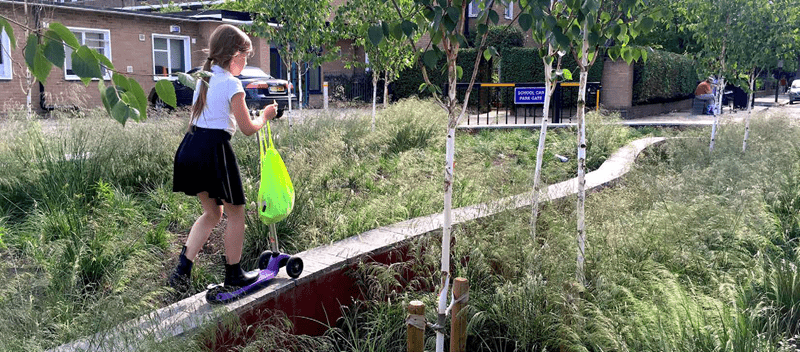
Native meadow basins with playful balance beams.
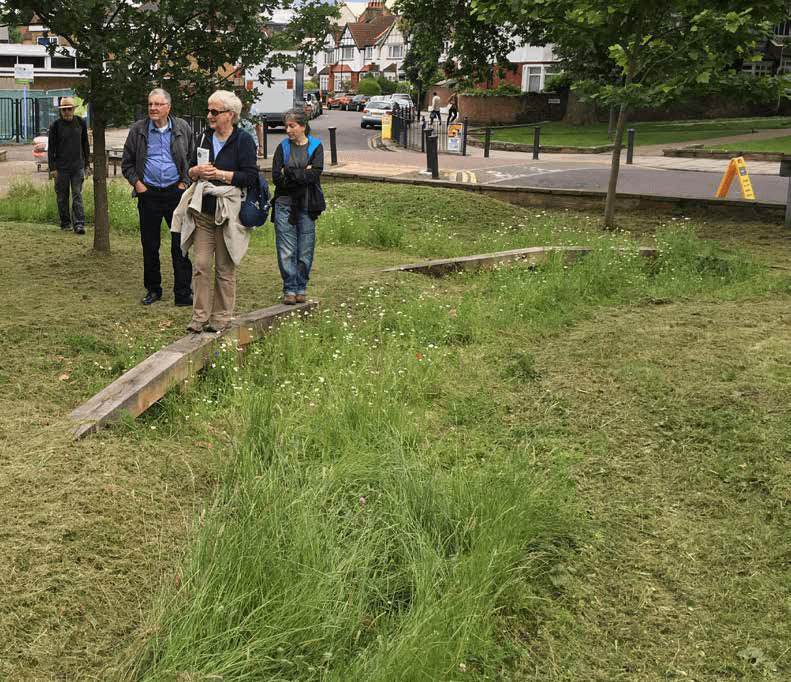
Belfast alleyway greening project - an example of how amenity space incorporating planting can be managed by local residents
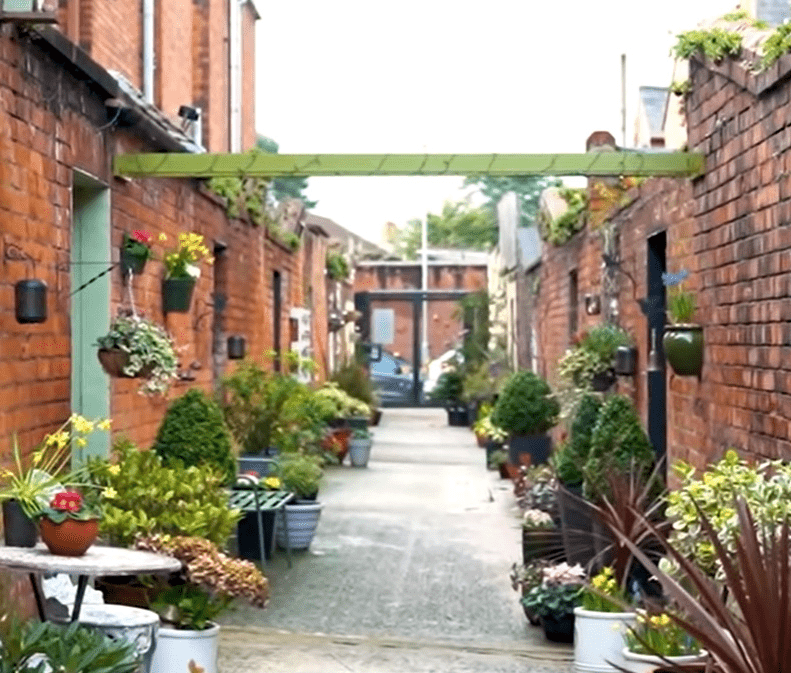
11.0 Managing SuDS now and in the future
In the same way that SuDS function in a different way to conventional drainage, so too is the way we look after SuDS. Planning applications should identify within a Management Plan how SuDS will be managed and confirm who will be responsible for the long term management and maintenance of these features
11.1 SuDS Maintenance
11.1.1 SuDS are generally ‘at or near the surface’, whether it be hard surfaces like permeable pavement, or vegetated features including basins, ponds or raingardens.
11.1.2 This aspect of SuDS ensures that most care is part of everyday site management, like sweeping permeable paving or cutting grass in swales and basins. A small element of care can be identified as ‘dedicated SuDS maintenance’ such as checking inlets, outlets and flow controls.
11.1.3 One of the major benefits of SuDS is that silts, heavy oils and tyre waste can be isolated ‘at source’, close to where they are collected, rather than distributed throughout the SuDS system or conveyed directly to streams, rivers or the sea. This initial cleaning means the rest of the SuDS features contain relatively clean water that can be used for amenity and wildlife benefits only requiring everyday landscape maintenance.
Polluted silts collecting at an inlet point from a busy road in London.
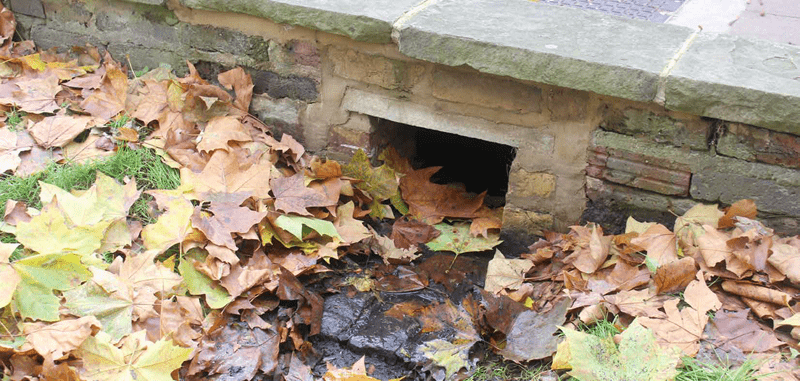
11.1.4 All man-made landscape features, including roads, paths, social spaces and green/blue infrastructure require maintenance. Minimising additional maintenance of SuDS ‘dedicated’ maintenance is therefore linked to integrating SuDS design into the landscape of the development which would receive regular upkeep, such as sweeping or litter removal.
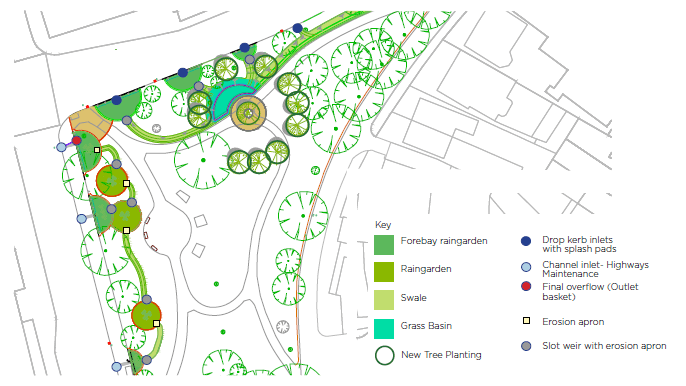
11.2 The SuDS Management Plan
11.2.1 The plan should begin with a description of the development, the role of SuDS in managing rainfall, and how it might change over time.
11.2.2 Site attendance for SuDS maintenance should integrate with regular everyday site care, usually monthly visits, to undertake site tasks like litter collection and grass mowing.
11.2.3 Occasional and remedial maintenance should be covered in the plan together with changes in the maintenance regime likely to occur over time. Maintenance work can be conveniently expressed in three timeframes:
- Regular maintenance - usually monthly or annually to match site care
- Occasional tasks – where frequency cannot be predicted accurately
- Remedial work – due to design failure or damage e.g. rutting of green space due to vehicles in wet weather.
11.2.4 There is currently no statutory body responsible for the management of SuDS. SuDS management plans should identify the tasks involved, the required frequency for specific tasks and who will be responsible for undertaking the tasks. Many sites across BCC will not be suitable for adoption, and for these sites the responsibility for management of SuDS will reside with the site owner.
11.3 Managing silt and vegetation waste on SuDS sites
11.3.1 Accumulation of silts and vegetation should be monitored visually and removed at convenient intervals.
11.3.2 Sweepings from permeable pavement can be managed in the same way as any other road sweepings.
11.3.3 Vegetation cuttings or prunings can be managed in wildlife piles on site, composted for mulching plant beds or removed in the usual way for composing or disposal.
11.3.4 Any other contaminated waste should be disposed of in accordance with advice from Belfast City Council and NIEA.
12.0 Glossary and list of acronyms
Glossary
Attenuation
Slow release of runoff from a development.
Construction (Design and Management) Regulations (CDM)
Regulations which emphasise the importance of addressing construction health and safety issues at the design phase of a construction project.
Conventional drainage
The traditional method of draining surface water using gully pots and subsurface pipes
Conveyance
Movement of water from one location to another
Discharge consent
Consent required for discharge to ground, watercourse or sewer provided and governed by the respective regulatory body
Exceedance flow routes
Design and consideration of above-ground areas that act as pathways permitting water to run safely over and to minimise the adverse effect of flooding on people and property. This is required when the design capacity of the drainage system (SuDS or traditional drainage) has been exceeded.
Exceedance pathways
Flow paths that do not form part of the designated drainage system that can provide safe passage of flow during extreme rainfall events.
Extreme events
Rainfall events of greater than 30-year return period (3.3 per cent probability). Can often lead to major flooding.
Flow control device
A device used for the control of surface water from an attenuation facility, e.g. a weir.
Green and Blue Infrastructure
In the context of an urbanised environment, green and blue infrastructure is to be all natural and semi-natural landscape elements that form a green-blue network. Blue landscape elements are linked to water. They can be swales, ponds and pond systems, wetlands, rills, canals or water courses.
Greenfield runoff
The runoff that would occur from the site in its undeveloped and undisturbed state. Greenfield runoff characteristics are described by peak flow and volumes of runoff for rainfall events of specified duration and return period (frequency of occurrence).
Impermeable
Will not allow water (or any liquid) to pass through it.
Infiltration
Release of water into the ground.
Interception losses
The capture and infiltration of small rainfall events up to about 5mm. Normally prevents surface water runoff reaching the drainage system.
Maintenance
Actions to prolong the operational condition of a scheme
Management train
The management of surface water runoff in a series of SuDS features as it drains from a site
Overflow
A structure which allows excess runoff from a SuDS component to be conveyed to the next part of the system
Permeability
A measure of the ease with which a fluid can flow through a porous medium. It depends on the physical properties of the medium, for example grain size, porosity, and pore shape.
Rainfall event
A single occurrence of rainfall before and after which there is a dry period that is sufficient to allow its effect on the drainage system to be defined.
Rainfall return period
A statistical measurement typically based on historic data over an extended period. For example, a 1 in 10-year rainfall event has a 10 per cent chance of being exceeded in any one year.
Runoff
Water flow over the ground surface to the drainage system. This occurs if the ground is impermeable, is saturated or rainfall is particularly intense.
Source control
Managing rainfall close to where it occurs as runoff.
Subcatchments
The site area is divided up into a number of discrete parcels of land
SuDS component
A structure or feature that is used to manage runoff in a sustainable manner.
SuDS retro-fit
Interventions where SuDS measures are constructed within an existing urban landscape.
Treatment stage
A sustainable drainage component that protects or improves surface runoff by reducing suspended sediments or contaminants.
Treatment train
A series of SuDS components, each designated to treat a different aspect of runoff that are implemented together to maximise their effectiveness. (See SuDS management train)
Two Stage SuDS treatment
A SuDS management train normally includes source control and site control SuDS features linked in series. The number of stages is not fixed and ‘The SuDS Manual’ (C697) provides guidance on the minimum number of treatment stages required.
Watercourse
Any channel or passage of whatever kind, whether natural or artificial, through which water flows and, includes any river, stream, canal, ditch, drain, cut, culvert, dyke, sluice, valve, sewer, overland carrier or millrace, but does not include any drain or sewer or any water main or service pipe vested in a sewerage undertaker.
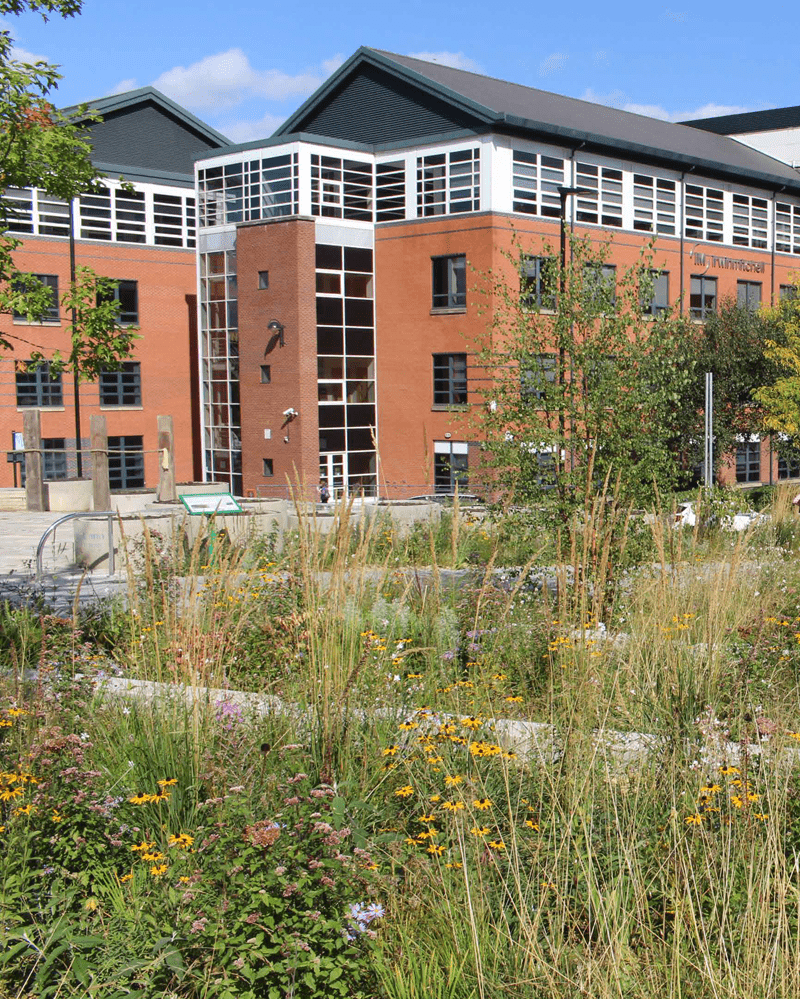
Acronyms used in this guide:
BCC
- Belfast City Council
CIRIA
- Construction Industry Research and Information Association
DfI
- Department for Infrastructure
GI
- Green Infrastructure
NIEA
- Northern Ireland Environment Agency
NIW
- Northern Ireland Water
PAD
- Pre-application discussion
RDS
- Regional Development Strategy
RoSPA
- Royal Society for the Prevention of Accidents
SPG
- Supplementary Planning Guidance
SPPS
- Strategic Planning Policy Statement
SuDS
- Sustainable Drainage Systems
Appendix A
SuDS cost comparison
A simple cost comparison between SuDS and piped drainage is not a straightforward ‘like for like’ comparison as SuDS is so different to conventional piped drainage.
| SUDS | CONVENTIONAL PIPED DRAINAGE |
|---|---|
| SuDS are at or near the surface | Pipes are underground and sometimes deep |
| SuDS are multi-objective delivering against ‘quantity, quality, amenity & biodiversity’ | Pipe objective is to convey water from source to outfall |
| SuDS storage ‘at source’ in a series of features along the management train | Storage at end of pipe system in balancing ponds, oversized pipe or tank |
| SuDS can be integrated into Development and features can have multiple functions. | Pipe drainage is separate and below development. Single purpose of providing conveyance of runoff. |
| Majority of SuDS maintenance can be part of everyday landscape care | Pipe drainage requires dedicated maintenance including gully pot emptying |
Pipe design has developed over many years with known accurate costs.
SuDS design depends on the type of site being developed, whether a city centre location or a development with more green space. SuDS costing is still evolving.
The following Graph has been extracted from independent study commissioned by Welsh Government (published 2017) which concluded that SuDS are less expensive to construct in comparison with conventional drainage for sites of all scales.
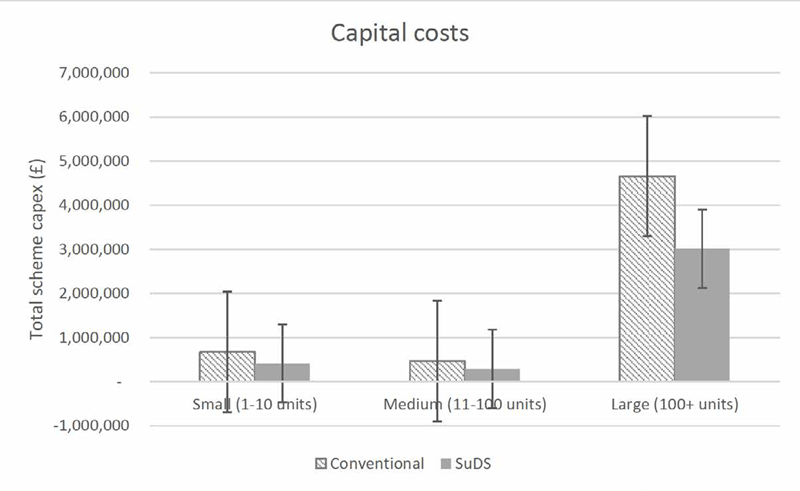
The feedback from elsewhere in the UK is that SuDS design approaches are changing from having dedicated SuDS space that are separate from development (commonly found in older designs) to integrating features like permeable paving and green/blue roofs in urban spaces which form part of the development.
Vegetated SuDS are now being designed as part of urban green space, particularly where clean water is ensured by using SuDS features for collection and initial cleansing of runoff. This multifunctional approach makes SuDS a cost beneficial option as SuDS form part of the development without incurring significant additional cost for drainage.
Where SuDS design takes a conventional drainage approach, runoff is collected in gully and pipe arrangements which do not clean dirty water sufficiently for fully useable SuDS landscapes. This may increase maintenance costs and the potential of using water as a resource may be lost.
This simplistic design approach (pipe to balancing pond) is still common today but increasing awareness of the benefits of well-designed SuDS and cost savings that follow from multi-functionality is seeing more innovative designs resulting in reduced SuDS costs, and SuDS maintenance being part of everyday site care.
Appendix B
PAD meeting checklist
In preparation for the PAD meeting it may be useful to collate some information on the following aspects of the development to facilitate informed discussion with BCC planning department;
- Topography,
- Geology,
- Existing historical drainage e.g. sewers or land drains,
- Discharge locations,
- Contamination issues,
- Existing landscape features,
- Habitat considerations.
Where a concept design is tabled for the PAD meeting some initial consideration should be given to :
- Runoff collection – how rainfall is collected and conveyed to SuDS features.
- Source control – runoff managed in SuDS features as close as possible to where rain falls.
- The management train – SuDS features linked in series, which convey flows along modified flow routes through the development.
- Sub-catchments – division of larger sites into small discrete areas that manage their own runoff.
- Maintenance – consideration of future maintenance requirements with reasonable care costs.
Appendix C
Consent for SuDS
Non-Planning Related
Early discussion between the design team and BCC, DfI Rivers, DfI Roads, DfI LWWP, NI Water and NIEA to ensure that future consenting in relation to SuDS is agreeable in principle will save the developer time and the cost of potential re-design, whilst providing BCC planning department with reassurance that the scheme will meet both local planning expectations and future consenting requirements of other regulatory bodies.
The following list outlines various consenting (or agreement) requirements that developers may require to have put in place. Failure to achieve consent may impact on adoption of other aspects of the site (such as highways) or ability to legally connect site drainage to a receiving sewer or water course. This list of consents is non-exhaustive; does not form part of the planning process; and is provided here for additional guidance to developers only.
| Recommended consultation | |
|---|---|
| Discharging runoff to a watercourse | Any discharge to a designated or non-designated watercourse (which by definition includes culverted streams, ditches, ponds and other natural water features which connect to a watercourse) will require Schedule 6 consent Drainage (NI) Order (1973). The developer should consult with DfI Rivers. |
| Designing SuDS which infiltrate storm runoff into the ground | The developer may consult with NIEA. Infiltration features may require consent under Water (NI) Order (1999). Licence to discharge storm runoff to ground may be required on sites where there is higher risk of pollution. |
| Discharge to an adopted surface water sewer | Where discharge of storm runoff is to a public main sewer, agreement will be required with NI Water under Article 161 of the Water and Sewerage Services Act (NI) 2016. A Pre-Development Enquiry should be made with NI Water to check for available capacity within the receiving sewer. |
| Discharge to an adopted combined sewer | |
| Discharge to a highway drain | Where discharge of storm runoff is to a highway drain, agreement will be required with DfI Roads. |
| Conveying water under a highway | The developer may require consent from DfI Roads where SuDS proposals include conveyance of runoff under or alongside an existing or proposed adoptable highway. |
